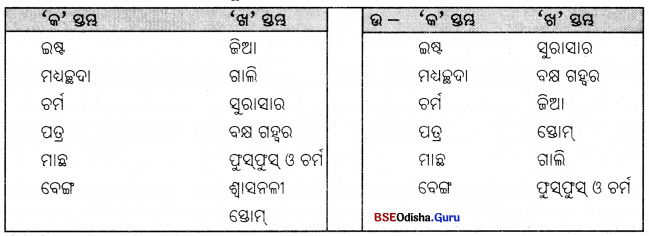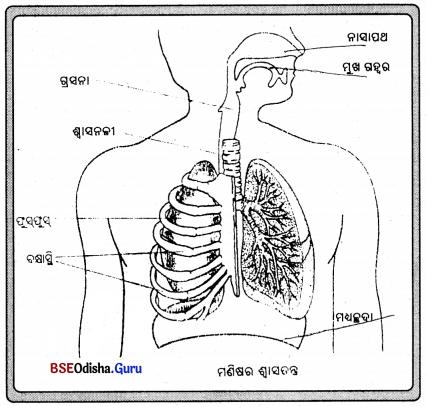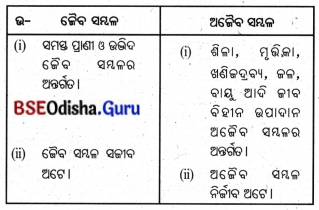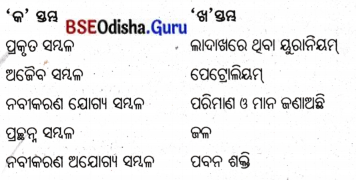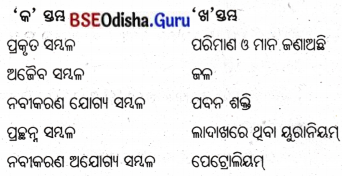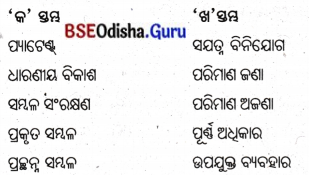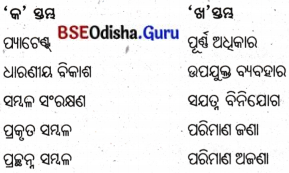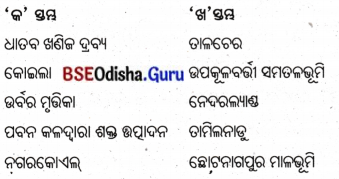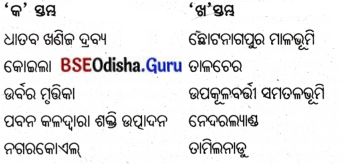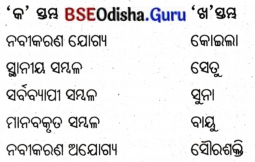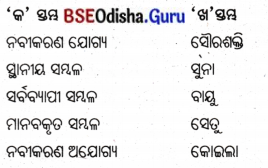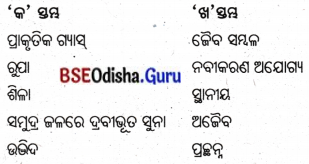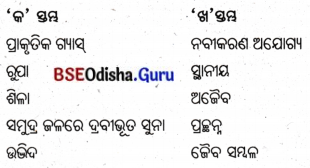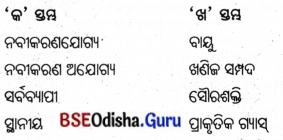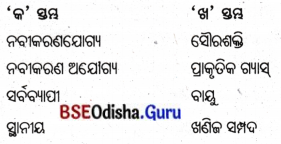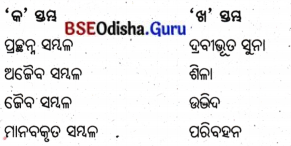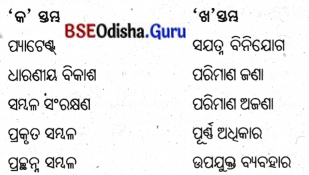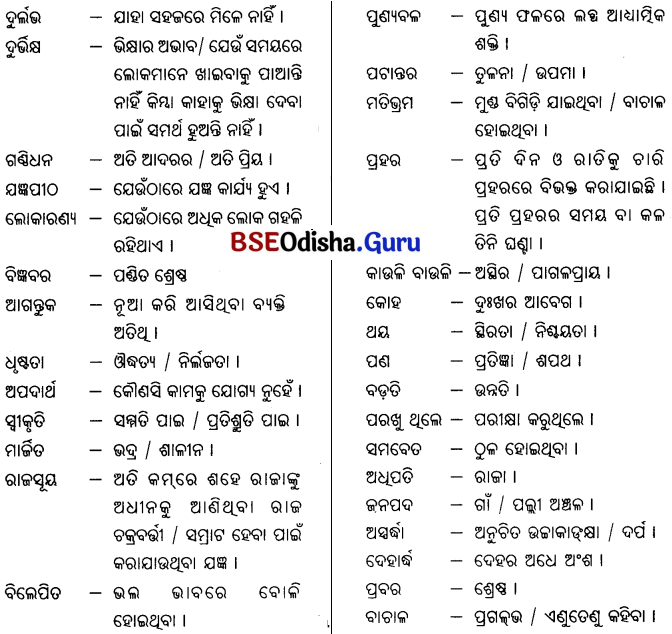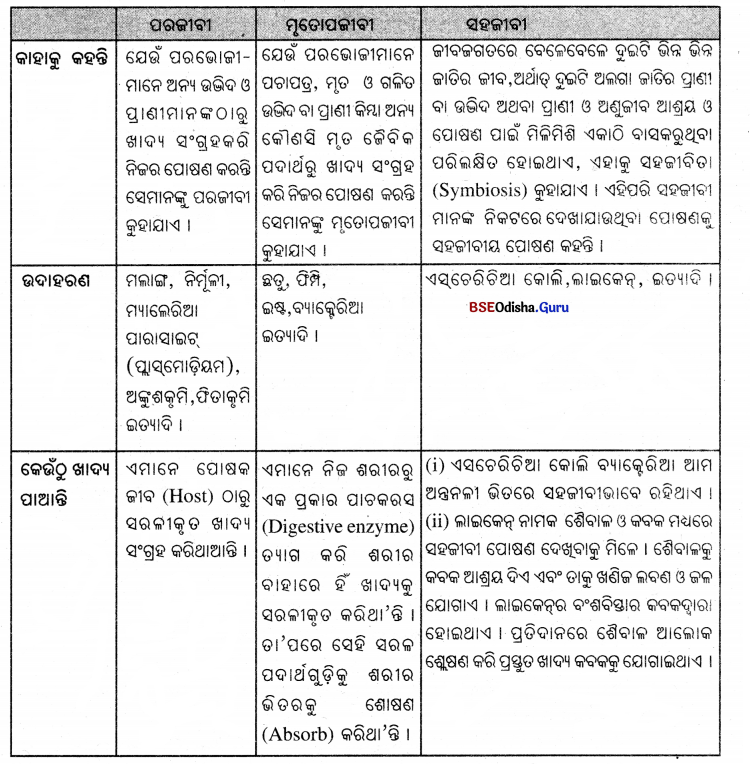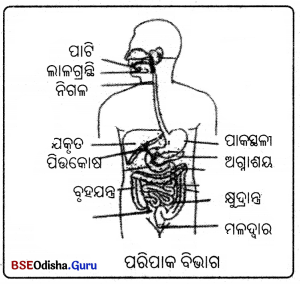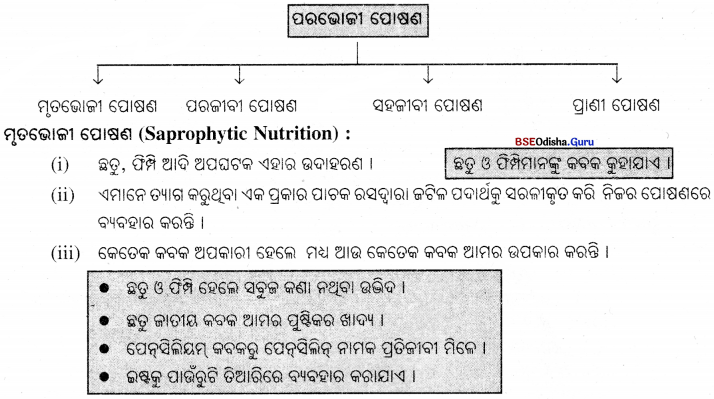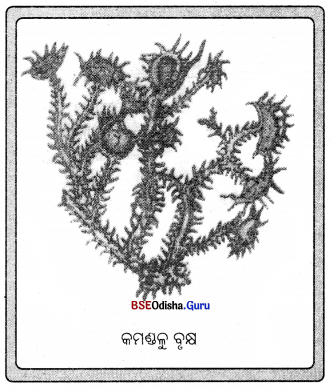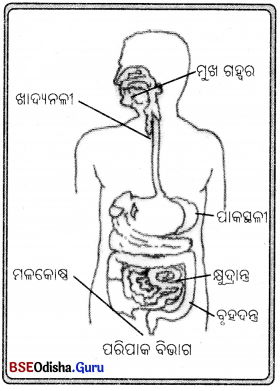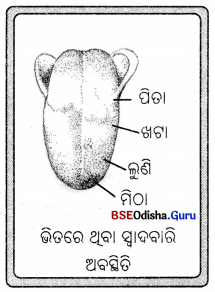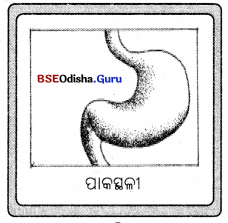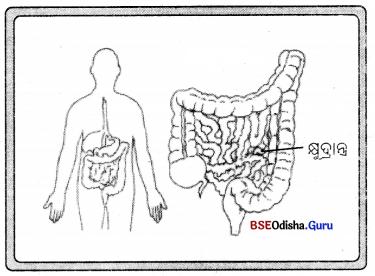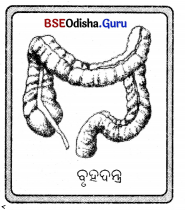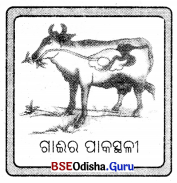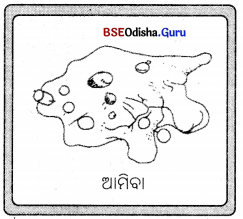Odisha State Board Plus Two First Year Sanskrit Optional Solutions Chapter 5 ସସେମିରାକଥା Textbook Exercise Questions and Answers.
Plus Two First Year Sanskrit Optional Chapter 5 ସସେମିରାକଥା Question Answer
अतिसंक्षेपेण उत्तरं लिखत
(क) बन्धनीमध्यात् शुद्धम् उत्तरं चित्वा लिखत-
Question 1.
_____________________ नन्दः नाम नरेन्द्रः आसीत्। (काश्यां, विशालायां, मथुरायां)
Answer:
विशालायां
Question 2.
विशालायां _____________________ नाम नरेन्द्रः आसीत्। (शान्तनुः, दुष्यन्तः, नन्दः)
Answer:
नन्दः
Question 3.
तस्य _____________________ नाम भायी। (तारावती, भानुमती, अग्रदूती)
Answer:
भानुमती
Question 4.
तस्य आसीत् _____________________ नाम अमात्यप्रवरः। (यौगन्धरायणः, शुद्धानन्दः, शारदानन्दः)
Answer:
शारदानन्दः
Question 5.
नृपनन्दनः _____________________ मृगयार्थं वनमगात्। (जयपाल, कामपालः, धर्मपालः)
Answer:
जयपाल

Question 6.
राजपुत्र: वने _____________________ दृष्टवान्। (व्याघ्रं, हस्तीं, कृष्णसारं)
Answer:
कृष्णसारं
Question 7.
व्याघ्रं दृष्ट्वा तुरङ्गमो _____________________ त्रोटयित्वा पलायमानो नगरमार्गमगात्। (वन्धनं, चन्दनं, रन्धनं)
Answer:
वन्धनं
Question 8.
राजपुत्र: _____________________ शरणागतः। (व्याघ्रस्य, भल्लूकस्य, वृक्षस्य)
Answer:
भल्लूकस्य
Question 9.
अतः शरणागतपरित्राणान्महत् _____________________ ते स्यात्। (पापं, पुण्यं, धर्मं)
Answer:
पुण्यं
Question 10.
_____________________ अस्तम् अगात्। (चन्द्रमा, नक्षत्रम्, तरणि:)
Answer:
तरणि:
Question 11.
राजपुत्रः भल्लूकस्य _____________________ सुष्वाप। (गृहे, अङ्के, मस्तके)
Answer:
अङ्के
Question 12.
एहि ममाङ्के _____________________ कुरु। (छिद्रां, क्षुद्रां, निद्रां)
Answer:
निद्रां
Question 13.
भल्लुकः _____________________। (जिह्वायुधः, नरवायुधः, शृङ्गायुधः)
Answer:
नरवायुधः
Question 14.
अहम् एनं _____________________ गमिष्यामि। (तापयित्वा, ताड़यित्वा, भक्षयित्वा)
Answer:
भक्षयित्वा
Question 15.
त्वमपि _____________________ याहि। (निजालयं, विद्यालयं, देवालयं)
Answer:
निजालयं
Question 16.
त्वमपि निज _____________________ गच्छ। (भवनं, नगरं, गृहं)
Answer:
नगरं

Question 17.
राजपुत्रः _____________________ इति वदन् पिशाचः वभूव। (ससेमिरा, समेसिरा, सरेमिसा)
Answer:
ससेमिरा
Question 18.
राजपुत्र ससेमिरा इति बदन् _____________________ वभूव। (राक्षस, असुर, पिशाच:)
Answer:
पिशाच:
Question 19.
_____________________ भवितव्यतानुसारिणी भवति। (मनः, वुद्धि:, भाग्य)
Answer:
वुद्धि:
Question 20.
अतस्तदन्वेषणार्थं _____________________ गमिष्यामः। (जल, स्थलं, वनं)
Answer:
वनं
Question 21.
राजाऽमात्यमण्डलपरिवृतो _____________________ आगत्य उपविष्टः। (मन्त्रिमन्दिरम्, देवमन्दिरम्, दासीमन्दिरम्)
Answer:
मन्त्रिमन्दिरम्
Question 22.
राज्ञोऽग्रे कथय यन्मम कापि _____________________ वर्त्तते। (भायी, कन्या, माता)
Answer:
कन्या
Question 23.
शारदानन्देन _____________________ पठितम्। (गीतं, गद्यं, पद्यं)
Answer:
पद्यं
Question 24.
अङ्कमारुह्य सुप्तानां हन्तुः किं नाम _____________________। (पौरुषम्, सौरभम्, विज्ञताम्)
Answer:
पौरुषम्
Question 25.
ब्रह्महापि प्रमुच्येत _____________________ न मुच्यते। (शत्रुद्रोही, मित्रद्रोही, राजद्रोही)
Answer:
मित्रद्रोही
Question 26.
राजपुत्रः स्वस्थः _____________________ चाभवत्। (सावधान:, सन्निधान, प्रधान:)
Answer:
सावधान:
Question 27.
राजपुत्र: _____________________ अग्रे भल्लुकवृत्तान्तमकथयत्। (मातुः, पितुः, भ्रातुः)
Answer:
पितुः
Question 28.
ततो राज्ञा _____________________ अपकृष्टा। (यवनिका, मदनिका, सागरिका)
Answer:
यवनिका
(ख) अतिसंक्षेपेण उत्तरं लिखत-
Question 1.
विशालायां कः नाम नरेन्द्रः आसीत्?
Answer:
ନନ୍ଦ
Question 2.
नन्दः कुत्र नरेन्द्रः आसीत्?
Answer:
ବିଶାଳାରେ

Question 3.
नन्दः केन सर्वानवनीपालान् विजित्य राज्यं शशास?
Answer:
ନିଜର ବାହୁବଳରେ
Question 4.
राजानन्दस्य भायी का आसीत्?
Answer:
ଭାନୁମତୀ
Question 5.
राजानन्दस्य अमात्यः कः आसीत्?
Answer:
ଶାରଦାନନ୍ଦ
Question 6.
शारदानन्दः कीदृशः आसीत्?
Answer:
ଇନ୍ଦ୍ରଙ୍କର ବୃହସ୍ପତି ଭଳି
Question 7.
नन्दः अमात्यशारदानन्दं किं कृतः?
Answer:
ନିଜ ରାଜ୍ୟରୁ ନିର୍ବାସିତ
Question 8.
राजानन्दस्य पुत्रः कः आसीत्?
Answer:
ଜୟପାଳ
Question 9.
राजपुत्रः किमर्थं कुत्र गत: च?
Answer:
ମୃଗୟା ନିମନ୍ତେ ବଣକୁ
Question 10.
वनमध्ये राजपुत्रः कं दृष्टवान्?
Answer:
କୃଷ୍ଣସାର ମୃଗକୁ
Question 11.
के मार्गे लग्नाः?
Answer:
ସୈନିକଗଣ
Question 12.
जयपालः यावत् पश्यति तावत् सकल: सैनिकगणो कुत्र लग्न?
Answer:
ମାର୍ଗରେ
Question 13.
वने कः नाम व्याघ्रः समागतः?
Answer:
ଚିତ୍ରକ
Question 14.
नृपसृनुः भयात् वेपमानः कम् आरूढ़:?
Answer:
ବୃକ୍ଷକୁ

Question 15.
कः अस्तम् अगात्?
Answer:
ସୂର୍ଯ୍ୟ
Question 16.
राजपुत्रः कुत्र सुष्वाप?
Answer:
ଭାଲୁର କୋଳରେ
Question 17.
कुत्र महत् पातकम्?
Answer:
ଶରଣାଗତକୁ ମାରିବାରେ
Question 18.
कः नखायुधः?
Answer:
ଭାଲୁ
Question 19.
राजपुत्रः किं कथयित्वा पिशाचः वभूव?
Answer:
ସସେମିରା
Question 20.
कः शून्य: नगरं जगाम?
Answer:
ଘୋଡ଼ା
Question 21.
कानू आहूय राजा पुत्रं चिकित्सितवान्?
Answer:
ମଣି-ମହୌଷଧୀମାନଙ୍କୁ
Question 22.
केन यत् कार्यं तद् विचाय्यैव कर्त्तव्यम्?
Answer:
ପୁରୁଷଦ୍ବାରା
Question 23.
राजा केन पुत्रस्य चिकित्साकर्त्तुम् इयेष?
Answer:
ଶାରଦାନନ୍ଦଙ୍କଦ୍ବାରା
Question 24.
राजा किं दातुम् उद्घोषितवान्?
Answer:
ଅର୍ଦ୍ଧେକ ରାଜ୍ୟ
Question 25.
शारदानन्दः कति श्लोकं पठितवान्?
Answer:
ଚାରିଗୋଟି
Question 26.
राजेन्द्र ! केभ्यो दानं देहि?
Answer:
ବ୍ରାହ୍ମଣମାନଙ୍କୁ
(ग) उत्कलभाषया अनुवादं कुरुत-
Question 1.
आसीत् विशालायां नन्दो नाम नरेन्द्रः।
Answer:
ବିଶାଳନଗରୀରେ ନନ୍ଦ ନାମକ ରାଜା ଥିଲେ ।
Question 2.
निजभुजवलेन सर्वानवनीपालान् विजित्य राज्यं शशास।
Answer:
ସେ ନିଜ ବାହୁବଳରେ ସମସ୍ତ ରାଜାଙ୍କୁ ଜୟକରି ରାଜ୍ୟ ଶାସନ କରୁଥିଲେ।
Question 3.
एकदा नृपनन्दनो जयपालो मृगयार्थं वनमगात्।
Answer:
ଥରେ ରାଜକୁମାର ଜୟପାଳ ଶିକାର ନିମନ୍ତେ ବନକୁ ଗଲେ ।
Question 4.
कृष्णसारोऽपि तत्रादृश्यो जात:।
Answer:
କୃଷ୍ଣସାର ମୃଗ ମଧ୍ୟ ସେଠି ଅଦୃଶ୍ୟ ହୋଇଗଲା।

Question 5.
एककी तुरगारूढ़: सरोवरस्य परिसरे वनमपश्यत्।
Answer:
ଏକୁଟିଆ ଘୋଡ଼ା ଚଢ଼ିଥିବା ସେ ପୁଷ୍କରିଣୀର ନିକଟରେ ବନ ଦେଖିଲେ।
Question 6.
तत्र पूर्वरूढं भल्लुकं विलोक्य पुनर्भृशं भयं प्राप्तः।
Answer:
ସେଠି ପୂର୍ବରୁ ଚଢ଼ିଥିବା ଭାଲୁକୁ ଦେଖୁ ସେ ଅତ୍ୟନ୍ତ ଭୟଭୀତ ହୋଇଗଲେ।
Question 7.
मां विश्वस्य शार्दूलादपि न भेतव्यम्।
Answer:
ମୋତେ ବିଶ୍ଵାସକରି ବାଘକୁ ମଧ୍ୟ ଡର ନାହିଁ।
Question 8.
अत: शरणागतपरित्राणान्महत् पुण्यं ते स्यात्।
Answer:
ଏଣୁ ଶରଣାପନ୍ନର ରକ୍ଷା ହେତୁ ତୁମର ମହାପୁଣ୍ୟ ହେବ।
Question 9.
तस्मादमुमधः पातय, अहमेनं भक्षयित्वा सुखेन गमिष्यामि।
Answer:
ତେଣୁ ଏହାଙ୍କୁ ତଳକୁ ପକାଅ, ମୁଁ ତାହାଙ୍କୁ ଭକ୍ଷଣକରି ସୁଖରେ ଚାଲିଯିବି।
Question 10.
यतः शरणागतमारणे महत् पातकम्।
Answer:
ଯେହେତୁ ଶରଣାପନ୍ନକୁ ମାରିବାରେ ବଡ଼ ପାପ ହୁଏ ।
Question 11.
ततो भल्लूको राजपुत्रसमीपे स्वापं गत:।
Answer:
ତାହାପରେ ଭାଲୁଟି ରାଜକୁମାରଙ୍କ ନିକଟରେ ଶୋଇଗଲା।
Question 12.
अयं त्वां मत्तो रक्षित्वा स्वयमत्तुमिच्छति।
Answer:
ଇଏ ତୁମକୁ ମୋଠାରୁ ରକ୍ଷାକରି ନିଜେ ଖାଇବାକୁ ଇଚ୍ଛା କରୁଛି।
Question 13.
अतस्त्वं ससेमिरा इति वदन् पिशाचो भव इति शापं दत्तवान्।
Answer:
ଏଣୁ ତୁମେ ‘ସସେମିରା’ କହି କହି ପିଶାଚ ହୁଅ ବୋଲି ଅଭିଶାପ ଦେଲା।
Question 14.
भल्लूकोऽपि राजकुमारं शप्त्वा निजस्थानं जगाम।
Answer:
ଭାଲୁ ବି ରାଜକୁମାରଙ୍କୁ ଶାପଦେଇ ନିଜସ୍ଥାନକୁ ଚାଲିଗଲା।
Question 15.
तस्य तरङ्गस्तेन शून्यो नगरं जगाम।
Answer:
ତାଙ୍କର ଘୋଡ଼ାଟି ତାଙ୍କ ବିହୁନେ ନଗରକୁ ଗଲା।
Question 16.
यदा कुमारो मृगयार्थं निर्गतस्तदा महानपशकुन: आसीत्।
Answer:
ଯେତେବେଳେ ରାଜକୁମାର ମୃଗୟାପାଇଁ ବାହାରିଲେ ସେତେବେଳେ ବଡ଼ ଅଶୁଭସୂଚକ ଲକ୍ଷଣ ଜଣାପଡ଼ୁଥିଲା।

Question 17.
तन्निराससमये केनापि न वारितोऽहम्।
Answer:
ତାଙ୍କୁ ନିର୍ବାସିତ କଲାବେଳେ କେହି ବି ମୋତେ ବାରଣ କଲେ ନାହିଁ।
Question 18.
तच्छ्रुत्वा राज्ञः पुरतो मन्त्रिणा तथैव कथितम्।
Answer:
ତାହା ଶୁଣି ରାଜାଙ୍କ ସମ୍ମୁଖରେ ମନ୍ତ୍ରୀ ସେହିପରି କହିଲେ।
Question 19.
एवमुक्तवति शारदानन्दे राजपुत्रः स्वस्थः सावधानश्चाभवत्।
Answer:
ଏହିପରି ଶାରଦାନନ୍ଦ କହନ୍ତେ ରାଜକୁମାର ସୁସ୍ଥ ଓ ସାବଧାନ ହୋଇଗଲେ।
Question 20.
ततः पितुरग्रे भल्लूकवृत्तान्तमकथयत्।
Answer:
ତାହାପରେ ପିତାଙ୍କ ଆଗରେ ଭାଲୁ ବୃତ୍ତାନ୍ତକୁ କହିଲେ।
संक्षेपेण उत्तरं लिखत-
Question 1.
कः शारदानन्दः? स कथं राज्यान्निवीसित:?
Answer:
ଶାରଦାନନ୍ଦ ଥିଲେ ବିଶାଳା ନଗରୀର ପରାକ୍ରମଶାଳୀ ରାଜା ନନ୍ଦଙ୍କର ପ୍ରଧାନମନ୍ତ୍ରୀ । ସେ ଇନ୍ଦ୍ରଙ୍କର ବୃହସ୍ପତି ସଦୃଶ ଥିଲେ । ଥରେ ଏକ ସାମାନ୍ୟ କାରଣରୁ ରାଜା ନନ୍ଦ ରାଗିଯାଇ ଶାରଦାନନ୍ଦଙ୍କୁ ରାଜ୍ୟରୁ ବହିଷ୍କୃତ କରିଥିଲେ।
Question 2.
राजकुमारः कदा तरुवरम् आरूढ़:?
Answer:
ରାଜକୁମାର ଜୟପାଳ ମୃଗୟାକୁ ଯାଇ ବନ ମଧ୍ୟରେ ବୁଲି ବୁଲି ଏକ ପୋଖରୀ ନିକଟରେ ପହଞ୍ଚିଲେ । ସେଠାରେ ଘୋଡ଼ାକୁ ଗଛଡାଳରେ ବାନ୍ଧି ପାଣି ପିଇବା ପରେ ବିଶ୍ରାମ ନେବାକୁ ଯାଉଥିବାବେଳେ ହଠାତ୍ ଏକ ବାଘ ଆସି ଉପସ୍ଥିତ ହେଲା । ଏଣୁ ସେହି ସମୟରେ ରାଜକୁମାର ଭୟରେ ଗଛ ଉପରକୁ ଚଢ଼ିଗଲେ।
Question 3.
भयं प्राप्तं राजपुत्रं भल्लुकः किमब्रवीत्?
Answer:
ଗଛ ଉପରେ ଭାଲୁକୁ ଦେଖୁ ରାଜକୁମାର ଭୟପ୍ରାପ୍ତ ହେବାରୁ ଭାଲୁ ତାଙ୍କୁ କହିଲା– ‘‘ରାଜକୁମାର, ଭୟ କର ନାହିଁ । ତୁମେ ଆଜି ମୋର ଶରଣାଗତ । ଏଣୁ ମୁଁ ତୁମର କୌଣସି ଅନିଷ୍ଟ କରିବି ନାହିଁ । ମୋତେ ବିଶ୍ଵାସ କରି ବାଘକୁ ମଧ୍ୟ ଭୟ କର ନାହିଁ ।’’
Question 4.
चित्रकः भल्लूकं किम् उक्तवान्?
Answer:
ରାଜପୁତ୍ରକୁ ଶୋଇପଡ଼ିବା ଦେଖ୍ ଚିତ୍ରକ ଭାଲୁକୁ କହିଲା– ଏହି ଗ୍ରାମବାସୀ ପୁନର୍ବାର ମୃଗୟା କରି ଆମ ସମସ୍ତଙ୍କୁ ମାରିଦେବ । କାହିଁକି ଏହାକୁ କୋଳରେ ଆଶ୍ରୟ ଦେଇଛ ? ମନୁଷ୍ୟମାନେ କୃତଘ୍ନ ଅଟନ୍ତି । ତେଣୁ ଏହାକୁ ତଳକୁ ଠେଲିଦିଅ । ମୁଁ ଖାଇସାରି ଚାଲିଯିବି । ତୁମେ ମଧ୍ୟ ଚାଲିଯିବ ।
Question 5.
व्याघ्रः राजकुमारं किमवदत्?
Answer:
ଭାଲୁ ଶୋଇପଡ଼ିବା ପରେ ବାଘ ରାଜପୁତ୍ରକୁ କହିଲା– ତୁମେ ଏହାକୁ ବିଶ୍ୱାସ କର ନାହିଁ । ଏହି ଭାଲୁ ଚଞ୍ଚଳମନା ହୋଇଥିବାରୁ ନଖକୁ ଅସ୍ତ୍ରରୂପେ ବ୍ୟବହାର କରିପାରେ । ଏହାର ଅନୁଗ୍ରହ ମଧ୍ଯ ଭୟଙ୍କର । ଏ ତୁମକୁ ମୋଠାରୁ ରକ୍ଷାକରି ନିଜେ ଖାଇବ । ଏଣୁ ଏହାକୁ ତଳେ ପକାଇଦିଅ । ମୁଁ ଖାଇସାରି ଚାଲିଯିବି । ତୁମେ ମଧ୍ଯ ନଗରକୁ ଚାଲିଯିବ ।
Question 6.
भल्लूकेन राजपुत्रः कथमभिशप्तः?
Answer:
ରାଜପୁତ୍ର ବାଘ କଥାରେ ବିଶ୍ଵାସ କରି ଭାଲୁକୁ ତଳକୁ ଠେଲିଦେଲା । ଭାଲୁଟି ପଡ଼ି ଯାଉଯାଉ ଏକ ଡାଳକୁ ଧରି ରହିଗଲା । ତେଣୁ ଭାଲୁ ରାଜପୁତ୍ରକୁ ଅଭିଶାପ ଦେଇ କହିଲା– ରେ ପାପିଷ୍ଠ କାହିଁକି ଡରୁଛୁ ? ତୋର ଯାହା ପୂର୍ବାର୍ଜିତ କର୍ମଫଳ ଅଛି, ତୋତେ ଭୋଗ କରିବାକୁ ପଡ଼ିବ । ଏଣୁ ତୁ ‘ସସେମିରା’ ବୋଲି କହି କହି ପିଶାଚ ହୋଇଯାଏ ।
Question 7.
राजकुमारविषये राजा मन्त्रिणः किमभणत्?
Answer:
ରାଜକୁମାର ବିଷୟରେ ରାଜା ମନ୍ତ୍ରୀମାନଙ୍କୁ କହିଲେ– ଯେତେବେଳେ ରାଜକୁମାର ମୃଗୟାକୁ ବାହାରିଲେ, ସେତେବେଳେ ବଡ଼ ଅଶୁଭ ଲକ୍ଷଣ ଦେଖାଯାଉଥିଲା । ସେ ତାହା ଉଲଂଘନ କରିଥିଲେ । ବର୍ତ୍ତମାନ ସେ ବସିଥିବା ଘୋଡ଼ାଟି ଏକାକୀ ଫେରି ଆସିଛି । ଏଣୁ ତାକୁ ଖୋଜିବାପାଇଁ ବଣକୁ ଯିବା ।
Question 8.
यदा राजपुत्रः स्वस्थः न अभवत्, राजा किमवदत्?
Answer:
ସମସ୍ତ ଚିକିତ୍ସା ସତ୍ତ୍ଵେ ଯେତେବେଳେ ରାଜପୁତ୍ର ସୁସ୍ଥ ହେଲେ ନାହିଁ, ରାଜା କହିଲେ– ମନ୍ତ୍ରିନ୍ ! ବର୍ତ୍ତମାନ ଯଦି ଶାରଦାନନ୍ଦ ଥାଆନ୍ତେ, କ୍ଷଣକରେ ସେ ଏହାକୁ ଭଲକରି ଦେଇଥା’ନ୍ତେ । ତାଙ୍କୁ ମୁଁ ତଡ଼ିଦେଇଛି । ମନୁଷ୍ୟ ପ୍ରତ୍ୟେକ କଥା ବିଚାର କରି କରିବା ଉଚିତ । ସେତେବେଳେ ମୋତେ କେହି ମଧ୍ୟ ବାଧା ଦେଲେ ନାହିଁ ।

Question 9.
राजपुत्रस्य आरोग्यार्थं राजा किं कृतवान्?
Answer:
ପିଶାଚ ପାଲଟି ଯାଇଥବା ରାଜପୁତ୍ରକୁ ଭଲ କରିବାପାଇଁ ରାଜା ମଣି, ମନ୍ତ୍ର ଓ ଔଷଧ ଜାଣିଥିବା ବୈଦ୍ୟଙ୍କଦ୍ବାରା ଚିକିତ୍ସା କରାଇଲେ । କୌଣସିମତେ ଭଲ ନ ହେବାରୁ ଘୋଷଣା କରାଇଲେ ଯେ, ରାଜପୁତ୍ରକୁ ଭଲ କରିଦେବା ବ୍ୟକ୍ତିକୁ ଅଧେ ରାଜ୍ୟ ପୁରସ୍କାର ଦିଆଯିବ ।
Question 10.
शारदानन्दः मन्त्रिणं किमुक्तवान्?
Answer:
ଶାରଦାନନ୍ଦ ମନ୍ତ୍ରୀଙ୍କୁ କହିଲେ– ମନ୍ତ୍ର ! ରାଜାଙ୍କ ଆଗରେ କୁହ ଯେ ମୋର ଗୋଟିଏ କନ୍ୟା ଅଛି । ରାଜକୁମାର ତାକୁ ସାକ୍ଷାତ୍ କରିବା ଆବଶ୍ୟକ । ସେ ଏଥିପାଇଁ କୌଣସି ଉପାୟ କରିବ।
Question 11.
राजा शारदानन्दं दृष्ट्वा किमकरोत्?
Answer:
ରାଜା ପରଦା ଉଠାଇଦେଇ ସେଠାରେ ବସିଥିବା ଶାରଦାନନ୍ଦଙ୍କୁ ଦେଖ୍ ପରମ ଆନନ୍ଦରେ ତାହାକୁ ପ୍ରଣାମ କରି କ୍ଷମା ଯାଚନାପୂର୍ବକ ସତ୍କାର କଲେ ।
Question 12.
‘ससेमिराकथायाः’ का नीतिशिक्षा लभ्यते?
Answer:
‘ସସେମିରାକଥା’ରୁ ଏହି ନୀତିଶିକ୍ଷା ମିଳୁଛି ଯେ–
- କସ୍ମିନ୍କାଳେ କୃତଘ୍ନତା ବା ବିଶ୍ୱାସକଘାତକତା କରିବା ଉଚିତ ନୁହେଁ ?
- ଶରଣାଗତକୁ ରକ୍ଷା କରିବା ପରମ ଧର୍ମ ଅଟେ।
- ମିତ୍ରଦ୍ରୋହଠାରୁ ଆଉ ବଡ଼ ପାପ ନାହିଁ ।
- କୃତକର୍ମର ଫଳ ନିଜକୁ ହିଁ ଭୋଗ କରିବାକୁ ପଡ଼ିବ ।
- ବିଚାର ନକରି କୌଣସି କାର୍ଯ୍ୟ କରିବା ଉଚିତ ନୁହେଁ ।
दीर्घप्रश्नोत्तराणि
Question 1.
राजपुत्रः कथं ‘ससेमिरा’ इति वदत् पिशाचोभूत्वा वने अभ्रमत्?
अथवा
विश्वासघातकस्य परिणतिं ससेमिराकथामाश्रित्य वर्णयत।
Answer:
କଥାସାହିତ୍ୟର ପରମ୍ପରା ଅତୀବ ପ୍ରାଚୀନ । ଶିବଦାସ କୃତ କଥାଗ୍ରନ୍ଥ ‘ବେତାଳପଞ୍ଚବିଂଶତି’ର ଅଂଶସ୍ୱରୂପ ‘ସସେମିରାକଥା’ । ନନ୍ଦରାଜାଙ୍କର ପୁତ୍ର ଜୟପାଳ ଥରେ ମୃଗୟା କରିବାକୁ ଯାଇ ଗୋଟିଏ ଶରବିଦ୍ଧ କୃଷ୍ଣସାର ମୃଗ ପଛରେ ଦୌଡ଼ି ଦୌଡ଼ି ସୈନ୍ୟମାନଙ୍କଠାରୁ ବହୁଦୂରକୁ ଚାଲିଗଲା । ସେମାନଙ୍କୁ ଦେଖିବାକୁ ସେ ପଛକୁ ଚାହିଁଲାବେଳେ ମୃଗଟି ମଧ୍ୟ ଅଦୃଶ୍ୟ ହୋଇଗଲା । ତା’ପରେ ବନ ମଧ୍ଯସ୍ଥ ଏକ ପୋଖରୀରୁ ପାଣି ପିଇ ବିଶ୍ରାମ ନେବାବେଳେ ହଠାତ୍ ଏକ ବାଘ ଆସିଲା । ତାକୁ ଦେଖୁ ତା’ର ଘୋଡ଼ା ବନ୍ଧନ ଛିଣ୍ଡାଇ ପଳାଇଗଲା ଏବଂ ସେ ଗଛ ଉପରକୁ ଚଢ଼ିଗଲା । ସେଠାରେ ଆଗରୁ ଚଢ଼ିଥିବା ଏକ ଭାଲୁକୁ ଦେଖୁ ସେ ଆହୁରି ଡରିଗଲା । ଏହା ଦେଖ୍ ଭାଲୁ ତାକୁ ଅଭୟ ପ୍ରଦାନ କଲା । ସେ ମଧ୍ୟ ଭାଲୁର ଆଶ୍ରୟ ପାଇ ନିଶ୍ଚିନ୍ତ ହେଲା ।
କ୍ରମଶଃ ରାତ୍ରି ହେଲା । କ୍ଳାନ୍ତ ରାଜପୁତ୍ରକୁ ନିଦ ଲାଗିବାରୁ ସେ ଭାଲୁର ପରାମର୍ଶରେ ତା’ କୋଳରେ ଶୋଇପଡ଼ିଲା । ଏହି ସମୟରେ ବାଘ ଭାଲୁକୁ କହିଲା– ‘‘ଏ ହେଉଛି ଗ୍ରାମବାସୀ । ପୁଣି ମୃଗୟା କରି ଆମ ସମସ୍ତଙ୍କୁ ମାରିଦେବ, ଏଣୁ ଏହାକୁ ତଳକୁ ପକାଇଦିଅ । ଭାଲୁ କିନ୍ତୁ ଶରଣାଗତ ପ୍ରତି ବିଶ୍ୱାସଘାତକତା କରିବାପାଇଁ ସ୍ୱମ୍ମତ ହେଲା ନାହିଁ ।’’
କିଛି ସମୟ ପରେ ରାଜପୁତ୍ରର ନିଦ ଭାଙ୍ଗିଲା । ସେତେବେଳେ ଭାଲୁ ମଧ୍ୟ ତା’ପାଖରେ କିଛି ସମୟ ପାଇଁ ଶୋଇପଡ଼ିଲା । ପୂର୍ବ ଭଳି ବାଘ ରାଜପୁତ୍ରକୁ ଲୋଭ ଦେଖାଇ ଭାଲୁକୁ ତଳକୁ ଠେଲି ଦେବାପାଇଁ କହିଲା । ରାଜପୁତ୍ର ତା’କଥାରେ ଭାଲୁକୁ ଠେଲିଦେବାରୁ ସେ ପଡ଼ୁ ପଡ଼ୁ ଅନ୍ୟ ଏକ ଡାଳ ଧରି ରହିଗଲା । ତା’ପରେ ସେ ରାଜପୁତ୍ରର ଏହି ବିଶ୍ଵାସଘାତକତା ହେତୁ ଅଭିଶାପ ଦେଇ କହିଲା– ‘ତୁ ‘ସସେମିରା’ ବୋଲି କହି କହି ପିଶାଚ ହୋଇଯା’ ।’’
ଏହିପରି ଭାବେ ରାଜପୁତ୍ର ଜୟପାଳ ‘ସସେମିରା’ ବୋଲି କହି କହି ପିଶାଚ ହୋଇ ବନ ମଧ୍ୟରେ ବୁଲିବାକୁ ଲାଗିଲା । ଅର୍ଥାତ୍ ରାଜପୁତ୍ର ଏହିପରି ଭାବେ ବିଶ୍ଵାସଘାତକତାର ଫଳ ପାଇଲା ।
Question 2.
पिशाचीभूतः राजकुमारः केन प्रकारेण सूस्थोऽभवत्?
Answer:
ବନ ମଧ୍ଯରେ ଭାଲୁର ଅଭିଶାପ ପାଇ କୃତଘ୍ନ ରାଜକୁମାର ‘ସସେମିରା’ ବୋଲି କହି କହି ପିଶାଚ ହୋଇଯାଇଥିଲା । କୌଣସି ପ୍ରକାରେ ତାଙ୍କୁ କେହି ଭଲକରି ପାରି ନ ଥିଲେ । ଶେଷରେ ମନ୍ତ୍ରୀ ରାଜାଙ୍କ ଆଦେଶରେ ଭଲ କରିଦେବା ବ୍ୟକ୍ତିକୁ ଅଧେ ରାଜ୍ୟ ଦିଆଯିବ ବୋଲି ଘୋଷଣା କରି ନିଜ ଘରକୁ ଯାଇଥିଲେ । ସେଠାରେ ପୂର୍ବରୁ ଲୁଚାଇ ରଖୁଥିବା ନିର୍ବାସିତ ମନ୍ତ୍ରୀପ୍ରଦର ଶାରଦାନନ୍ଦଙ୍କ ଆଗରେ ସବୁକଥା କହିଲେ । ଶାରଦାନନ୍ଦ ସମସ୍ତ ବିଷୟ ବୁଝିପାରି କହିଲେ– ‘‘ରାଜାଙ୍କୁ ଯାଇ କହନ୍ତୁ ଯେ ମୋର ଏକ କନ୍ୟା ଅଛି । ରାଜପୁତ୍ର ତାଙ୍କ ସହିତ ସାକ୍ଷାତ କରନ୍ତୁ, ସେ କୌଣସି ବାଟ ବତାଇଦେବ ।’’ ମନ୍ତ୍ରୀ ଏକଥା ରାଜାଙ୍କୁ ଜଣାଇ ଦେବାପାରେ ସେ ଅମାତ୍ୟମାନଙ୍କ ସହ ଆସି ମନ୍ତ୍ରୀଙ୍କ ଘରେ ଉପସ୍ଥିତ ହେଲେ । ରାଜକୁମାର ମଧ୍ୟ ‘ସସେମିରା’ ବୋଲି କହି କହି ସେଠାରେ ଆସି ବସିଲା । ତାକୁ ଦେଖୁ ପରଦା ଆଢୁଆଳରେ ଥିବା ଶାରଦାନନ୍ଦ କହିଲେ– ‘‘ସଦ୍ଭାବ ପୋଷଣ କରୁଥିବା ବନ୍ଧୁଙ୍କୁ ଠକିବାରେ କୌଣସି ଚତୁରତା ନାହିଁ କିମ୍ବା କୋଳକୁ ଆଶ୍ରୟ କରି ଶୋଇଥିବା ବ୍ୟକ୍ତିକୁ ହତ୍ୟା କରିବାରେ ବୀରତ୍ଵ ପ୍ରକାଶ ପାଏନି ।’’ ଏହା ଶୁଣି ରାଜକୁମାର ପ୍ରଥମ ଅକ୍ଷରଟି ଛାଡ଼ି କେବଳ ‘ସେମିରା’ କହିଲା ।
ଶାରତାନନ୍ଦ ପୁଣି କହିଲେ– ‘ତୀର୍ଥଭ୍ରମଣଦ୍ୱାରା ବ୍ରହ୍ମହତ୍ୟା ପାପ ଦୂର ହୋଇପାରେ କିନ୍ତୁ ମିତ୍ରଦ୍ରୋହୀକୁ କୌଣସି ଉପାୟରେ ନିଷ୍ପତି ମିଳେ ନାହିଁ ।’’ ଏହା ଶୁଣି ରାଜପୁତ୍ର କେବଳ ‘ମିରା’ କହିବାକୁ ଲାଗିଲା ।
ଶାରଦାନନ୍ଦ ପୁଣି କହିଲେ– ‘ମିତ୍ରଦ୍ରୋହୀ, କୃତଘ୍ନ ତଥା ବିଶ୍ୱାସଘାତକ ପ୍ରଳୟକାଳ ପର୍ଯ୍ୟନ୍ତ ନର୍କରେ ପଡ଼ନ୍ତି ।’’ ଏତିକି ଶୁଣି ରାଜପୁତ୍ର କେବଳ ଶେଷ ଅକ୍ଷରଟି ଅର୍ଥାତ୍ ‘ରା’ କହିଲା ।
ଶେଷରେ ଶାରଦାନନ୍ଦ ରାଜାଙ୍କୁ କହିଲେ– ‘‘ମହାରାଜ ! ପୁତ୍ରର ମଙ୍ଗଳ ପାଇଁ ବ୍ରାହ୍ମଣମାନଙ୍କୁ ଦାନ ଦିଅନ୍ତୁ ଏବଂ ଦେବାରାଧନା କରନ୍ତୁ ।’’ ଏହା ଶୁଣି ରାଜପୁତ୍ର ଶେଷ ଅକ୍ଷରଟିକୁ ମଧ୍ଯ ଉଚ୍ଚାରଣ କଲା ନାହିଁ । ଏହିପରି ଭାବରେ ରାଜକୁମାର ସମ୍ପୂର୍ଣ୍ଣରୂପେ ସୁସ୍ଥ ଓ ସଚେତନ ହୋଇ ଯାଇଥିଲେ ।

Question 3.
ससेमिराकथायाः सारं स्वभाषया लिखत।
Answer:
ବିଶାଳା ନଗରୀରେ ନନ୍ଦ ନାମକ ଜଣେ ପରାକ୍ରମଶାଳୀ ରାଜା ଥିଲେ । ଶାରଦାନନ୍ଦ ତାଙ୍କର ପ୍ରଧାନମନ୍ତ୍ରୀ ଥିଲେ । ସାମାନ୍ୟ କାରଣରୁ ରାଜା ତାଙ୍କୁ ରାଜ୍ୟରୁ ତଡ଼ି ଦେଇଥିଲେ । ଥରେ ରାଜପୁତ୍ର ଜୟପାଳ ମୃଗୟା କରିବାକୁ ଯାଇ ଶରବିଦ୍ଧ କୃଷ୍ଣସାର ମୃଗ ପଛରେ ଦୌଡ଼ି ଦୌଡ଼ି ସୈନ୍ୟମାନଙ୍କଠାରୁ ଦୂରେଇ ଯାଇଥିଲେ । ଏଣେ କୃଷ୍ଣସାରକୁ ମଧ୍ୟ ପାଇଲେ ନାହିଁ । ଶେଷରେ ଘୋଡ଼ାରେ ବସି ବୁଲୁବୁଲୁ ବନ ମଧ୍ୟରେ ଏକ ପୋଖରୀ ଦେଖୁଲେ । ପାଣି ପିଇ ଗଛତଳେ ବିଶ୍ରାମ ନେବାକୁ ଯିବାବେଳେ ହଠାତ୍ ଏକ ବାଘ ଆସି ପହଞ୍ଚିଲା । ତାକୁ ଦେଖୁ ଘୋଡ଼ା ନଗର ଆଡ଼କୁ ଦୌଡ଼ିବାରେ ଲାଗିଲା ଏବଂ ରାଜପୁତ୍ର ଭୟରେ ଗଛ ଉପରକୁ ଚଢ଼ିଗଲା । କିନ୍ତୁ ସେଠାରେ ପୂର୍ବରୁ ଚଢ଼ିଥିବା ଭାଲୁକୁ ଦେଖୁ ଆହୁରି ଡରିଗଲା । କିନ୍ତୁ ଭାଲୁ ତାକୁ ଅଭୟ ପ୍ରଦାନ କରି ଆଶ୍ରୟ ଦେଲା ।
ରାତିରେ କ୍ଳାନ୍ତ ରାଜପୁତ୍ର ଭାଲୁର ଆଶ୍ଵାସନା ପାଇ ତା’ କୋଳରେ ଶୋଇପଡ଼ିଲା । ଏହି ସମୟରେ ତଳେ ଥିବା ବାଘ ଭାଲୁକୁ କହିଲା– ‘ଏହି ଗ୍ରାମବାସୀ ପୁଣି ମୃଗୟାକୁ ଆସି ଆମ ସମସ୍ତଙ୍କୁ ମାରିଦେବ । ଏଣୁ ଆମର ଏହି କୃତଘ୍ନ ଶତ୍ରୁକୁ ତଳକୁ ଠେଲିଦିଅ ।’’ ଶରଣାଗତକୁ ମାରିଲେ ପାପ ଲାଗେ ବୋଲି କହି ଭାଲୁ ତା’ କଥାରେ ରାଜି ହେଲା ନାହିଁ ।
ରାଜପୁତ୍ର ନିଦ୍ରା ତ୍ୟାଗ କରିବା ପରେ ଭାଲୁ ତାକୁ ଚେଇଁ ରହିବାକୁ କହି ଶୋଇପଡ଼ିଲା । ଏହି ସମୟରେ ବାଘ କହିଲା– ‘‘ରାଜପୁତ୍ର ! ତୁମେ ଏହି ନଖଧାରୀକୁ ବିଶ୍ୱାସ କର ନାହିଁ । ସେ ମୋଠାରୁ ତୁମକୁ ରକ୍ଷାକରି ନିଜେ ଖାଇବାକୁ ଇଚ୍ଛା କରୁଛି । ଏଣୁ ଏହାକୁ ଠେଲିଦିଅ । ମୁଁ ତାକୁ ଖାଇ ଚାଲିଯିବି ।’’ ବାଘ କଥା ଶୁଣି ରାଜପୁତ୍ର ଭାଲୁକୁ ଠେଲିଦେବା ମାତ୍ରେ ସେ ପଡ଼ୁ ପଡ଼ୁ ଗୋଟିଏ ଡାଳ ଧରି ରହିଗଲା । ଏହା ଦେଖୁ ରାଜକୁମାରଙ୍କ ଭୟର ସୀମା ରହିଲା ନାହିଁ । ଏହା ଦେଖ୍ ଭାଲୁ ତାକୁ ଅଭିଶାପ ଦେଇ କହିଲା— ‘ସସେମିରା’ କହି କହି ପିଶାଚ ହୋଇଯାଅ ।’’ ସକାଳ ହେଲା । ବାଘ ଚାଲିଗଲା । ତା’ପରେ ଭାଲୁ ମଧ୍ୟ ଚାଲିଗଲା । ତା’ ଅଭିଶାପ ଅନୁସାରେ ରାଜପୁତ୍ର ‘ସସେମିରା’ କହି କହି ପିଶାଚ ହୋଇ ବୁଲିଲା ।
ଘୋଡ଼ାଟି ରାଜକୁମାରଙ୍କୁ ଛାଡ଼ି ନଗରକୁ ଏକାକୀ ଗଲା । ଏକଥା ଜାଣି ରାଜା, ମନ୍ତ୍ରୀ ଓ ସୈନ୍ୟମାନଙ୍କ ସହିତ ପୁତ୍ରକୁ ଖୋଜିବାପାଇଁ ବଣକୁ ଗଲେ । ସେଠାରେ ପୁତ୍ରର ସେହି ଅବସ୍ଥା ଦେଖୁ ଦୁଃଖରେ ତାକୁ ଧରି ନଗରକୁ ଆସିଲେ । ତା’ପରେ ବହୁତ ଚିକିତ୍ସା ପାଇ ମଧ୍ଯ ସେ ଆରୋଗ୍ୟ ଲାଭ କରିନଥିଲେ । ଏଣୁ ତାଙ୍କ ଆଦେଶରେ ମନ୍ତ୍ରୀ– ‘ଯେ ଆରୋଗ୍ୟ କରିପାରିବ ତାକୁ ରାଜ୍ୟରୁ ଅଧେ ଦିଆଯିବ’’ ବୋଲି ଘୋଷଣା କଲେ । ଏଣେ ଘରକୁ ଆସି ଲୁଚାଇ ରଖୁଥୁବା ଶାରଦାନନ୍ଦଙ୍କୁ ସବୁକଥା କହିଲେ । ତା’ପରେ ଶାରଦାନନ୍ଦଙ୍କ ପରାମର୍ଶ ଅନୁସାରେ ସେ ଯାଇ ରାଜାଙ୍କୁ କହିଲେ– ‘ମୋର ଗୋଟିଏ କନ୍ୟା ଅଛି । ରାଜକୁମାର ତାକୁ ଯାଇ ଦେଖାକରନ୍ତୁ । ସେ କିଛି ଉପାୟ କହିବ ।’’ ଏହା ଶୁଣି ରାଜା ପୁତ୍ରକୁ ନେଇ ମନ୍ତ୍ରୀଙ୍କ ଘରକୁ ଗଲେ । ପରଦା ଆଢୁଆଳରେ ଥିବା ଶାରଦାନନ୍ଦ ରାଜପୁତ୍ରର ବିଶ୍ଵାସଘାତକତା କ୍ରମଶଃ ଚାରିଗୋଟି ପଦ୍ୟ ସାହାଯ୍ୟରେ ବର୍ଣ୍ଣନା କରି କହିଲେ । ପ୍ରତି ପଦ୍ୟପାଠ ପରେ ରାଜପୁତ୍ର ଗୋଟିଏ ଗୋଟିଏ ଅକ୍ଷର ପରିତ୍ୟାଗ କରି ଶେଷରେ ‘ସସେମିରା’ ଶବ୍ଦଟିକୁ ଉଚ୍ଚାରଣ କରିବା ସମ୍ପୂର୍ଣ୍ଣରୂପେ ବନ୍ଦ କରିଦେଲା ଏବଂ ସୁସ୍ଥ ହୋଇ ସବୁକଥା ରାଜାଙ୍କ ଆଗରେ ବର୍ଣ୍ଣନା କଲା। ଇତି ମଧ୍ୟରେ ରାଜା ପରଦାଟିକୁ ଟେକି ଦେବାମାତ୍ରେ ଶାରଦାନନ୍ଦଙ୍କୁ ଦେଖୁ ଅତ୍ୟନ୍ତ ଆନନ୍ଦିତ ହେଲେ ଏବଂ ତାଙ୍କୁ ସତ୍କାର କଲେ।
+2 1st Year Sanskrit Optional Chapter 5 ସସେମିରାକଥା Summary
ଲେଖକ ପରିଚୟ – ସଂସ୍କୃତ କଥାସାହିତ୍ୟରେ ‘ବେତାଳପଞ୍ଚବିଂଶତି’ର ସ୍ଥାନ ସ୍ୱତନ୍ତ୍ର । ଏହାର ରଚୟିତା ରୂପେ ଜମ୍ବଳ ଦତ୍ତ ଓ ଶିବଦାସଙ୍କ ନାମ ଉଲ୍ଲିଖୁତ । ଜମ୍ବଳ ଦତ୍ତଙ୍କ ରଚନା କେବଳ ଗଦ୍ୟାତ୍ମକ ହୋଇଥିବାବେଳେ ଶିବଦାସଙ୍କ ବିରଚିତ ଗ୍ରନ୍ଥ ଉଭୟ ଗଦ୍ୟାତ୍ମକ ଓ ପଦ୍ୟାତ୍ମକ ଅଟେ । ଏକାଦଶ ଶତାବ୍ଦୀରେ ରଚିତ ଯୋଗେନ୍ଦ୍ରଙ୍କ ‘ବୃହତ୍ଥାମଞ୍ଜରୀ’ ଓ ସୋମଦେବଙ୍କର ‘କଥାସରିତ୍ସାଗର’ରେ ଏହି କଥାର ଅସ୍ତିତ୍ବ ଉପଲବ୍ଧୂ ହୁଏ । ୧୪୮୭ରେ ପ୍ରାପ୍ତ ହସ୍ତଲିପି ଆଧାରରେ ଡକ୍ଟର ହର୍ଟଲ୍ ଶିବଦାସ ୧୪୮୭ ଖ୍ରୀଷ୍ଟାବ୍ଦର ପୂର୍ବରୁ ଲେଖୁଥିବାର ପ୍ରମାଣ ଦିଅନ୍ତି । ତେବେ ଏହାଙ୍କର ସମୟ ଦ୍ଵାଦଶ ଶତାବ୍ଦୀ ବୋଲି ସ୍ବୀକୃତ ହୋଇଥାଏ ।
ବିଷୟ ପ୍ରବେଶ – ସଂସ୍କୃତ ଆଖ୍ୟାନ ସାହିତ୍ୟର ପ୍ରାଚୀନତା ତଥା ମୌଳିକତା ସର୍ବଜନବିଦିତ । ଏଥିପାଇଁ ଏହା ଅତ୍ୟନ୍ତ ଲୋକପ୍ରିୟ ଅଟେ । ‘ବେତାଳପଞ୍ଚବିଂଶତି’ରେ ୨୫ଗୋଟି କୌତୂହଳପୂର୍ଣ୍ଣ ଗଳ୍ପର ସଂଗ୍ରହ ହୋଇଛି । ରାଜା ବିକ୍ରମାର୍କ ଓ ବେତାଳକୁ ନେଇ ଗଳ୍ପଗୁଡ଼ିକ ରଚିତ ହୋଇଅଛି । ଏହି ଗ୍ରନ୍ଥରେ ବର୍ଣ୍ଣିତ କଥାନକର ମୂଳ ‘ବୃହତ୍ଵକଥା’ରୁ ସଂଗୃହୀତ । ବେତାଳର ଜଟିଳ ପ୍ରଶ୍ନମାନଙ୍କର ବୁଦ୍ଧିଦୀପ୍ତ ଉତ୍ତର ରାଜା ତ୍ରିବିକ୍ରମସେନ ପ୍ରଦାନ କରିଛନ୍ତି । ଏହି କଥାରୁ ବ୍ୟକ୍ତି ଓ ସାମାଜିକ ନୀତି ବିଷୟରେ ସମୁଚିତ ଶିକ୍ଷା ମିଳେ । ଆଲୋଚିତ କଥାନକ ‘ସସେମିରାକଥା’ରେ ନନ୍ଦରାଜାଙ୍କ ପୁତ୍ର ଜୟପାଳ ଆଶ୍ରୟଦାତା ଭଲ୍ଲୁକ ସହିତ କିପରି ବିଶ୍ୱାସଘାତକତା କରି ତା’ ଫଳ ଭୋଗ କରିଥିଲେ ତାହା ବର୍ଣ୍ଣନା କରାଯାଇଛି ।
ସାରକଥା – ବିଶାଳା ନଗରୀରେ ନନ୍ଦ ନାମକ ଜଣେ ପରାକ୍ରମଶାଳୀ ରାଜା ଥିଲେ । ଶାରଦାନନ୍ଦ ତାଙ୍କର ପ୍ରଧାନମନ୍ତ୍ରୀ ଥିଲେ । ସାମାନ୍ୟ କାରଣରୁ ରାଜା ତାଙ୍କୁ ରାଜ୍ୟରୁ ତଡ଼ି ଦେଇଥିଲେ । ଥରେ ରାଜପୁତ୍ର ଜୟପାଳ ମୃଗୟା କରିବାକୁ ଯାଇ ଶରବିଦ୍ଧ କୃଷ୍ଣସାର ମୃଗ ପଛରେ ଦୌଡ଼ି ଦୌଡ଼ି ସୈନ୍ୟମାନଙ୍କଠାରୁ ଦୂରେଇ ଯାଇଥିଲେ । ଏଣେ କୃଷ୍ଣସାରକୁ ମଧ୍ୟ ପାଇଲେ ନାହିଁ । ଶେଷରେ ଘୋଡ଼ାରେ ବସି ବୁଲୁବୁଲୁ ବନ ମଧ୍ୟରେ ଏକ ପୋଖରୀ ଦେଖୁଲେ । ପାଣି ପିଇ ଗଛତଳେ ବିଶ୍ରାମ ନେବାକୁ ଯିବାବେଳେ ହଠାତ୍ ଏକ ବାଘ ଆସି ପହଞ୍ଚିଲା। ତାକୁ ଦେଖୁ ଘୋଡ଼ା ନଗର ଆଡ଼କୁ ଦୌଡ଼ିବାରେ ଲାଗିଲା ଏବଂ ରାଜପୁତ୍ର ଭୟରେ ଗଛ ଉପରକୁ ଚଢ଼ିଗଲା । କିନ୍ତୁ ସେଠାରେ ପୂର୍ବରୁ ଚଢ଼ିଥିବା ଭାଲୁକୁ ଦେଖୁ ଆହୁରି ଡରିଗଲା । କିନ୍ତୁ ଭାଲୁ ତାକୁ ଅଭୟ ପ୍ରଦାନ କରି ଆଶ୍ରୟ ଦେଲା ।
ରାତିରେ କ୍ଳାନ୍ତ ରାଜପୁତ୍ର ଭାଲୁର ଆଶ୍ଵାସନା ପାଇ ତା’ କୋଳରେ ଶୋଇପଡ଼ିଲା । ଏହି ସମୟରେ ତଳେ ଥିବା ବାଘ ଭାଲୁକୁ କହିଲା– ‘ଏହି ଗ୍ରାମବାସୀ ପୁଣି ମୃଗୟାକୁ ଆସି ଆମ ସମସ୍ତଙ୍କୁ ମାରିଦେବ । ଏଣୁ ଆମର ଏହି କୃତଘ୍ନ ଶତ୍ରୁକୁ ତଳକୁ ଠେଲିଦିଅ ।’’ ଶରଣାଗତକୁ ମାରିଲେ ପାପ ଲାଗେ ବୋଲି କହି ଭାଲୁ ତା’ କଥାରେ ରାଜି ହେଲା ନାହିଁ ।
ରାଜପୁତ୍ର ନିଦ୍ରା ତ୍ୟାଗ କରିବା ପରେ ଭାଲୁ ତାକୁ ଚେଇଁ ରହିବାକୁ କହି ଶୋଇପଡ଼ିଲା । ଏହି ସମୟରେ ବାଘ କହିଲା– ‘‘ରାଜପୁତ୍ର ! ତୁମେ ଏହି ନଖଧାରୀକୁ ବିଶ୍ୱାସ କର ନାହିଁ । ସେ ମୋଠାରୁ ତୁମକୁ ରକ୍ଷାକରି ନିଜେ ଖାଇବାକୁ ଇଚ୍ଛା କରୁଛି । ଏଣୁ ଏହାକୁ ଠେଲିଦିଅ । ମୁଁ ତାକୁ ଖାଇ ଚାଲିଯିବି ।’’ ବାଘ କଥା ଶୁଣି ରାଜପୁତ୍ର ଭାଲୁକୁ ଠେଲିଦେବା ମାତ୍ରେ ସେ ପଡ଼ୁ ପଡ଼ୁ ଗୋଟିଏ ଡାଳ ଧରି ରହିଗଲା । ଏହା ଦେଖୁ ରାଜକୁମାରର ଭୟର ସୀମା ରହିଲା ନାହିଁ । ଏହା ଦେଖ୍ ଭାଲୁ ତାକୁ ଅଭିଶାପ ଦେଇ କହିଲା— ‘ସସେମିରା’ କହି କହି ପିଶାଚ ହୋଇଯାଅ ।’’ ସକାଳ ହେଲା । ବାଘ ଚାଲିଗଲା । ତା’ପରେ ଭାଲୁ ମଧ୍ୟ ଚାଲିଗଲା । ତା’ ଅଭିଶାପ ଅନୁସାରେ ରାଜପୁତ୍ର ‘ସସେମିରା’ କହି କହି ପିଶାଚ ହୋଇ ବୁଲିଲା ।
ଘୋଡ଼ାଟି ରାଜକୁମାରଙ୍କୁ ଛାଡ଼ି ନଗରକୁ ଏକାକୀ ଗଲା । ଏକଥା ଜାଣି ରାଜା, ମନ୍ତ୍ରୀ ଓ ସୈନ୍ୟମାନଙ୍କ ସହିତ ପୁତ୍ରକୁ ଖୋଜିବାପାଇଁ ବଣକୁ ଗଲେ । ସେଠାରେ ପୁତ୍ରର ସେହି ଅବସ୍ଥା ଦେଖୁ ଦୁଃଖରେ ତାକୁ ଧରି ନଗରକୁ ଆସିଲେ । ତା’ପରେ ବହୁତ ଚିକିତ୍ସା ପାଇ ମଧ୍ୟ ସେ ଆରୋଗ୍ୟ ଲାଭ କରିନଥିଲେ । ଏଣୁ ତାଙ୍କ ଆଦେଶରେ ମନ୍ତ୍ରୀ– ‘ଯେ ଆରୋଗ୍ୟ କରିପାରିବ ତାକୁ ରାଜ୍ୟରୁ ଅଧେ ଦିଆଯିବ’’ ବୋଲି ଘୋଷଣା କଲେ । ଏଣେ ଘରକୁ ଆସି ଲୁଚାଇ ରଖୁଥିବା ଶାରଦାନନ୍ଦଙ୍କୁ ସବୁକଥା କହିଲେ । ତା’ପରେ ଶାରଦାନନ୍ଦଙ୍କ ପରାମର୍ଶ ଅନୁସାରେ ସେ ଯାଇ ରାଜାଙ୍କୁ କହିଲେ– ‘ମୋର ଗୋଟିଏ କନ୍ୟା ଅଛି । ରାଜକୁମାର ତାକୁ ଯାଇ ଦେଖାକରନ୍ତୁ । ସେ କିଛି ଉପାୟ କହିବ ।’’ ଏହା ଶୁଣି ରାଜା ପୁତ୍ରକୁ ନେଇ ମନ୍ତ୍ରୀଙ୍କ ଘରକୁ ଗଲେ । ପରଦା ଆଢୁଆଳରେ ଥିବା ଶାରଦାନନ୍ଦ ରାଜପୁତ୍ରର ବିଶ୍ୱାସଘାତକତା କ୍ରମଶଃ ଚାରିଗୋଟି ପଦ୍ୟ ସାହାଯ୍ୟରେ ବର୍ଣ୍ଣନା କରି କହିଲେ । ପ୍ରତି ପଦ୍ୟପାଠ ପରେ ରାଜପୁତ୍ର ଗୋଟିଏ ଗୋଟିଏ ଅକ୍ଷର ପରିତ୍ୟାଗ କରି ଶେଷରେ ‘ସସେମିରା’ ଶବ୍ଦଟିକୁ ଉଚ୍ଚାରଣ କରିବା ସମ୍ପୂର୍ଣ୍ଣରୂପେ ବନ୍ଦ କରିଦେଲା ଏବଂ ସୁସ୍ଥ ହୋଇ ସବୁକଥା ରାଜାଙ୍କ ଆଗରେ ବର୍ଣ୍ଣନା କଲା।
ଇତି ମଧ୍ୟରେ ରାଜା ପରଦାଟିକୁ ଟେକିଦେବାମାତ୍ରେ ଶାରଦାନନ୍ଦଙ୍କୁ ଦେଖ୍ ଅତ୍ୟନ୍ତ ଆନନ୍ଦିତ ହେଲେ ଏବଂ ତାଙ୍କୁ ସତ୍କାର କଲେ।
ନୀତିଶିକ୍ଷା—
- ‘‘କର୍ମାୟରଂ ଫଳ ପୁଂସାଂ ବୁଦ୍ଧି କର୍ମାନୁସାରିଣୀ ।’’
- ମିତ୍ରଦ୍ରୋହୀ କୃତଘ୍ନଶ୍ଚ ଯଶ୍ଚ ବିଶ୍ଵାସଘାତକଃ ।
ତ୍ରୟସ୍ତେ ନରକଂ ଯାନ୍ତି ଯାବଦାରୁତସଂପ୍ଲବମ୍ ॥
- ଧର୍ମେଣ ହୀନଃ ପଶୁଭଃ ସମାନାଃ ।
- ପରବୁଦ୍ଧିବିନାଶାୟ ।
Text – 1
आसीत् विशालायां …………………………… मार्गे लग्नः।
ଶବ୍ଦାର୍ଥ – ନରେନ୍ଦ୍ର = ରାଜା । ନିଜଭୁଜବଳେନ = ନିଜ ବାହୁବଳରେ । ଅବନୀପାଳାନ୍ = ରାଜାମାନଙ୍କୁ । ବିଜିତ୍ୟ ଜୟକରି । ଶଶାସ୍ତ୍ର = ଶାସନ କରୁଥିଲେ । ଭାର୍ଯ୍ୟା = ସ୍ତ୍ରୀ । ପୁରନ୍ଦରସ୍ୟ = ଇନ୍ଦ୍ରଙ୍କର । ଅମାତ୍ୟପ୍ରବରଃ = ଶ୍ରେଷ୍ଠ ମନ୍ତ୍ରୀ । ନିର୍ବାସିତଃ = ଦେଶାନ୍ତର ହେଲେ । ନୃପନନ୍ଦନଃ = ରାଜପୁତ୍ର । ମୃଗୟାର୍ଥମ୍ = ଶିକାର ନିମନ୍ତେ । ଅଗାତ୍ = ଗଲେ । ବ୍ୟାପାଦ୍ୟ = ମାରି । କଞ୍ଚନ = କୌଣସି । ଦୃଷ୍ଟା = ଦେଖ୍ । ମହଦରଣ୍ୟ = ଘୋର ବନ ମଧ୍ୟରେ । ପ୍ରବିଷ୍ଟ = ପ୍ରବେଶ କଲେ । ଯାବତ୍ = ଯେପର୍ଯ୍ୟନ୍ତ । ତାବତ୍ = ସେପର୍ଯ୍ୟନ୍ତ । ଅନୁଗତଃ = ପଛେ ପଛେ ଯାଇ । ମାର୍ଗେ ଲଗ୍ନ = ବାଟରେ ରହିଯାଇଥିଲେ ।
ଅନୁବାଦ – ବିଶାଳା ନଗରୀରେ ନନ୍ଦ ନାମକ ଜଣେ ରାଜା ଥିଲେ । ସେ ନିଜ ବାହୁବଳରେ ସମସ୍ତ ରାଜାମାନଙ୍କୁ ଜିଣି ରାଜ୍ୟଶାସନ କରୁଥିଲେ । ଇନ୍ଦ୍ରଙ୍କର ବୃହସ୍ପତି ପରି ତାଙ୍କର ଶାରଦାନନ୍ଦ ନାମକ ଶ୍ରେଷ୍ଠ ମନ୍ତ୍ରୀ ଥିଲେ । ଥରେ ସାମାନ୍ୟ କାରଣରୁ ରାଜା ରାଗିଯାଇ ତାଙ୍କୁ ରାଜ୍ୟରୁ ବହିଷ୍କୃତ କଲେ । ଦିନେ ରାଜକୁମାର ଜୟପାଳ ଶିକାର କରିବାପାଇଁ ବଣକୁ ଗଲେ । ସେଠାରେ ଅନେକ ପଶୁ ମାରିବା ପରେ କୌଣସି କୃଷ୍ଣସାର ମୃଗକୁ ଦେଖୁ ତା’ ପଛେ ପଛେ ଯାଇ ଘଞ୍ଚ ଅରଣ୍ୟରେ ପ୍ରବେଶ କରି ଯେତେବେଳେ ଦେଖିଲେ, ସେତେବେଳକୁ ସମସ୍ତ ସୈନିକ ବାଟରେ ରହିଯାଇଥିଲେ ।
ବ୍ୟାକରଣ
ସନ୍ଧିବିଚ୍ଛେଦ – ନନ୍ଦା ନାମ = ନମଃ + ନାମ । ନରେନ୍ଦ୍ର = ନର + ଇନ୍ଦ୍ର । ସର୍ବାନବନୀପାଳାନ୍ = ସର୍ବାନ୍ + ଅବନୀପାଳାନ୍ । ବୃହସ୍ପତିରିବ = ବୃହସ୍ପତିଃ + ଇବ । ତସ୍ୟାସୀଚ୍ଛାରଦାନନ୍ଦ = ତଥ୍ୟ + ଆସୀତ୍ + ଶାରଦାନନ୍ଦ । ନାମାମାତ୍ୟପ୍ରବରଃ = ନାମ + ଅମାତ୍ୟପ୍ରବରଃ । ନିଜରାଜ୍ୟ।ନିର୍ବାସିତଃ = ନିଜରାଜ୍ୟାତ୍ + ନିର୍ବାସିତଃ । ବନମଗାତ୍ = ବନମ୍ + ଅଗାତ୍ । କଞ୍ଚନ = କଂ + ଚନ । ତମନୁଗତଃ = ତମ୍ + ଅନୁଗତଃ । ମହଦରଣ୍ୟ = ମହତ୍ + ଅରଣ୍ୟ ।
ସମାସ – ନରେନ୍ଦ୍ର = ନରେଷୁ ଇନ୍ଦ୍ର ଇବ (ଉପମିତ କର୍ମଧାରୟ) । ନିଜଭୁଜବଳେନ = ନିଜସ୍ୟ ଭୁର୍ଜେ (୬ଷ୍ଠୀ ତତ୍ତ୍ଵପୁରୁଷ), ନିଜଭୁଜୟୋ ବଳମ୍, ତେନ (୬ଷ୍ଠୀ ତତ୍ପୁରୁଷ) । ଅବନୀପାଳାନ୍ = ଅବନୀ ପାଳୟନ୍ତି ଇତି, ତାନ୍ (ଉପପଦ ତତ୍ପୁରୁଷ) । ବୃହସ୍ପତିଃ = ବୃହତାଂ ପତିଃ (୬ଷ୍ଠୀ ତତ୍ପୁରୁଷ) । ଅମାତ୍ୟପ୍ରଦରଃ = ଅମାତ୍ୟେଷୁ ପ୍ରବରଃ (୭ମୀ ତତ୍ତ୍ଵପୁରୁଷ) । କ୍ଷୁଦ୍ରକାରଣାତ୍ = କ୍ଷୁଦ୍ର କାରଣମ୍, ତସ୍ମାତ୍ (କର୍ମଧାରୟ) । ଭୂପତିନା = ଭୁବ ପତିଃ, ତେନ ( ୬ଷ୍ଠୀ ତତ୍ତ୍ଵପୁରୁଷ) । ନିଜରାଜ୍ୟାଚ୍ ନିଜସ୍ୟ ରାଜ୍ୟମ୍, ତନ୍ମାତ୍ (୬ଷ୍ଠୀ ତତ୍ତ୍ଵପୁରୁଷ) । ନୃପନନ୍ଦନଃ = ନୃପସ୍ୟ ନନ୍ଦନଃ (୬ଷ୍ଠୀ ତତ୍ତ୍ଵପୁରୁଷ) । ମୃଗୟାର୍ଥମ୍ = ମୃଗାୟାୟ ଇଦମ୍ (ନିତ୍ୟ) । ମହଦରଣ୍ୟ = ମହତ୍ଵ ଅରଣ୍ୟମ୍, ତସ୍ମିନ୍ (କର୍ମଧାରୟଃ) ।

ସକାରଣବିଭକ୍ତି – ନରେନ୍ଦ୍ର, ଡଃ, ଭାର୍ଯ୍ୟା, ବୃହସ୍ପତିଃ, ଅମାତ୍ୟପ୍ରବରଂ, ନୃପନନ୍ଦନଃ, ଜୟପାଳ, ସକଳୀ, ସୈନିକଗଶଃ = କଉଁରି ୧ ମା । ନନ୍ଦୀ, ଭାନୁମତୀ, ଶାରଦାନନ୍ଦ = ନାମ ଅବ୍ୟୟ ଯୋଗେ ୧ମା । ଡଃ = ଉକ୍ତ କର୍ମଣି ୧ମା । ସର୍ବାନ୍, ଅବନୀପାଳାନ୍, ରାଜ୍ୟ, ମୃଗୟାର୍ଥୀ, ବହୁନ୍, ପଶୁନ୍, କୃଷ୍ଣସାରମ୍ = କର୍ମଣି ୨ୟା । ତମ୍ = ଅନୁ ଯୋଗେ ୨ୟା । ନିଜଭୁଜବଳେନ = କରଣେ ୩ୟା । କୁପିତେନ, ଭୂପତିନା = ଅନୁସ୍ତେ କଉଁରି ୩ୟା । କ୍ଷୁଦ୍ରକାରଣାତ୍ = ହେତୌ ୫ମୀ । ନିଜରାଜ୍ୟାତ୍ = ଅପାଦାନେ ୫ମୀ । ତସ୍ୟ, ପୁରନ୍ଦରସ୍ୟ = ଶେଷ ଷଷ୍ଠୀ । ଅରଣ୍ୟ, ମାର୍ଗ = ଅଧିକରଣେ ୭ମୀ ।
ପ୍ରକୃତିପ୍ରତ୍ୟୟ – ବିଜିତ୍ୟ = ବି + ଜି + ଲ୍ୟାପ୍ । ନିର୍ବାସିତଃ = ନିର୍ + ବସ୍ + ଣିଚ୍ + କ୍ତ । ବ୍ୟାପାଦ୍ୟ = ବି + ଆଡ୍ + ପଦ୍ + ଲ୍ୟାପ୍ । ଦୃଷ୍ଟା = ଦୃଶ୍ + କ୍ଵାଚ୍ । ଅନୁଗତଃ = ଅନୁ + ଗମ୍ + କ୍ତ । ପ୍ରବିଷ୍ଟ = ପ୍ର + ବିଶ୍ + କ୍ତ ।
Text – 2
कृष्णसारोऽपि ………………………………… भयं प्राप्तः।
ଶବ୍ଦାର୍ଥ – ଅପି = ମଧ୍ୟ । ତତ୍ର = ସେଠାରେ । ତୁରଗାରୂଢ଼ = ଘୋଡ଼ାଚଢ଼ି । ପରିସରେ = ନିକଟରେ । ଅବତୀର୍ୟ୍ଯ = ଓହ୍ଲାଇଲେ । ବଣ୍ଟା = ବାନ୍ଧି ଦେଇ । ବିଧାୟ = ବିଧାନ କରି । ଅତିକରାତଃ = ଅତ୍ୟନ୍ତ ଭୟଙ୍କର । ସମାଗତଃ = ଆସିଲା । ତୁରଙ୍ଗମଃ = ଘୋଡ଼ା । ତ୍ରୋଟୟିତ୍ୱ = ଛିଡ଼ାଇ । ଅଗାତ୍ = ଚାଲିଲା । ନୃପସୁନଃ = ରାଜକୁମାର ବା ରାଜପୁତ୍ର । ବେପମାନଃ = ଥରି ଥରି । ଆଲକ୍ଷ୍ୟ = ଧରି । ପୂର୍ବାରୂଢ଼ମ୍ = ଆଗରୁ ଚଢ଼ିଥିବା । ଭୃଶମ୍ = ଅତ୍ୟନ୍ତ ।
ଅନୁବାଦ – କୃଷ୍ଣସାର (ମୃଗ) ମଧ୍ୟ ତାଙ୍କ ଆଗରୁ ଅଦୃଶ୍ୟ ହୋଇଯାଇଥିଲା । ଏକାକୀ ଘୋଡ଼ାରେ ଚଢ଼ି ସେ ସରୋବର ନିକଟରେ ବଣ ଦେଖୁଲେ । ସେଠାରେ ଘୋଡ଼ାରୁ ଓହ୍ଲାଇ ଗଛ ଡାଳରେ ଘୋଡ଼ାକୁ ବାନ୍ଧି ପାଣି ପିଇବା ପରେ ଯେତେବେଳେ ଗଛଛାଇରେ ବସିଲେ, ସେତେବେଳେ ଚିତ୍ରକ ନାମକ ଅତିଶୟ ଭୟଙ୍କର ଗୋଟିଏ ବାଘ ଆସି ପହଞ୍ଚିଲା । ତାକୁ ଦେଖୁ ଘୋଡ଼ା ବନ୍ଧନ ଛିଣ୍ଡାଇ ନଗର ଆଡ଼କୁ ପଳାୟନ କଲା । ରାଜପୁତ୍ର ମଧ୍ୟ ଭୟରେ ଥରି ଥରି ଡାଳ ଧରି ଗଛ ଉପରକୁ ଚଢ଼ିଗଲା । ସେଠାରେ ପୂର୍ବରୁ ଚଢ଼ିଥିବା ଭାଲୁକୁ ଦେଖୁ ସେ ପୁଣି ଅତିଶୟ ଭୟଭୀତ ହେଲା ।
ବ୍ୟାକରଣ
ସନ୍ଧିବିଚ୍ଛେଦ – କୃଷ୍ଣସାରୋଽପି = କୃଷ୍ଣସାରଃ + ଅପି । ତତ୍ରାଦୃଶ୍ୟ = ତତ୍ର + ଅଦୃଶ୍ୟ । ତୁରଗାରୂଢ଼ୀ = ତୁରଗ + ଆରୂଢ଼ । ବନମପଶ୍ୟତ୍ = ବନମ୍ + ଅପଶ୍ୟତ୍ । ତତ୍ରାଶ୍ୱଦବତୀର୍ୟ୍ଯ = ତତ୍ର + ଅଶ୍ୱତ୍ + ଅବତୀର୍ଶୀ । ବୃକ୍ଷଶାଖାୟାମଶ୍ୱମ୍ = ବୃକ୍ଷଶାଖାୟାମ୍ + ଅଶ୍ଵମ୍ । ଯାବଦ୍ରୁପଦିଶତି = ଯାବତ୍ + ଉପବିଶତି । ତାବଦ୍ଧତିକରାଳଚ୍ଚିତ୍ରକଃ = ତାବତ୍ + ଅତିକରାଳଚିତ୍ରକଃ । କଣ୍ଠିତ୍ = କଃ + ଚିତ୍ । ନଗରମାର୍ଗମଗାତ୍ = ନଗରମାର୍ଗମ୍ + ଅଗାତ୍ । ନୃପସୁନୁରପି = ନୃପସୁନୁଃ + ଅପି । ଶାଖାମାଲମ୍ବୀ = ଶାଖାମ୍ + ଆଲକ୍ଷ୍ୟ । ତରୁବରମାରୂଢ଼ା = ତରୁବରମ୍ + ଆରୂଢ଼ । ପୂର୍ବାରୂଢ଼ମ୍ = ପୂର୍ବ + ଆରୂଢ଼ମ୍ । ପୁନଶମ୍ : = ପୁନଃ + ଭୃଶମ୍ ।
ସମାସ – ଅଦୃଶ୍ୟ = ନ ଦୃଶ୍ୟ (ନଞ୍ଚ୍ ତତ୍ପୁରୁଷ) । ତୁରଗାରୂଢ଼ୀ = ତୁରଗମ୍ ଆରୂଢ଼ (ଦ୍ଵିତୀୟା ତତ୍ପୁରୁଷ) । ବୃକ୍ଷଶାଖାୟାମ୍ = ବୃକ୍ଷସ୍ୟ ଶାଖା, ତସ୍ୟାମ୍ (୬୩ ତତ୍ତ୍ଵପୁରୁଷ) । ଜଳପାନମ୍ = ଜଳସ୍ୟ ପାନମ୍ (୬ଷ୍ଠୀ ତତ୍ତ୍ଵପୁରୁଷ) । ବୃକ୍ଷଛାୟାୟାମ୍ = ବୃକ୍ଷସ୍ୟ ଛାୟା, ତସ୍ୟାମ୍ (୬ଷ୍ଠୀ ତତ୍ପୁରୁଷ) । ନଗରମାର୍ଗମ୍ = ନଗରସ୍ୟ ମାର୍ଗମ (୬ଷ୍ଠୀ ତତ୍ପୁରୁଷ) । ନୃପସୁନଃ = ନୃପସ୍ୟ ସୁନୁଃ (୬ଷ୍ଠୀ ତତ୍ପୁରୁରଃ) । ପୂର୍ବାରୂଢ଼ମ୍ = ପୂର୍ବମ୍ ଆରୂଢ଼ ଯସ୍ୟ ସ, ତମ୍ (ବହୁବ୍ରୀହିଃ) ।
ସକାରଣବିଭକ୍ତ – ଏକାକୀ, ତୁରଗାରୂଢ଼ୀ, ବ୍ୟାଘ୍ର, ତୁରଙ୍ଗମଃ, ବେପମାନଃ କଉଁରି ୧ମା । କୃଷ୍ଣସାରଃ, ଅତିକରାଳଚିତ୍ରକ, ନୃପସୁନଃ = ଅବ୍ୟୟ ଯୋଗେ ୧ମା । ବନଂ, ଅହଂ, ଜଳପାନଂ, ତଂ, ବନ୍ଧନଂ, ନଗରମାର୍ଗମ୍, ପୂର୍ବାରୂଢ଼, ଭଲ୍ କଂ, ଭୟମ୍ = କର୍ମଣି ୨ୟା । ଭୃଶମ୍ = କ୍ରିୟା ବିଶେଷଣେ ୨ୟା । ଅଶ୍ଵତ୍ = ଅପାଦାନେ ୫ମୀ । ଭୟାତ୍ = ହେତୋ ୫ମୀ । ସରୋବରସ୍ୟ = ଶେଷେ ୬ଷ୍ଠୀ । ପରିସରେ, ବୃକ୍ଷଶାଖାୟାମ୍, ବୃକ୍ଷଚ୍ଛାୟାୟାମ୍ = ଅଧିକରଣେ ୭ମୀ ।
ପ୍ରକୃତିପ୍ରତ୍ୟୟ – ଜାତଃ = ଜନ୍ + କ୍ତ । ଆରୂଢ଼ = ଆ + ରୁହ୍ + କ୍ତ । ଅବତୀର୍ୟ୍ଯ = ଅବ୍ + ତୃ + କ୍ତ । ବର୍ଚ୍ଛା = ବନ୍ଦ୍ + କ୍ଵାଚ୍ । ପାନମ୍ = ପା + ଲ୍ୟୁଟ୍ । ବିଧାୟ = ବି + ଧା + ଲ୍ୟାପ୍ । ସମାଗତଃ = ସମ୍ + ଆ + ଗମ୍ + କ୍ତ । ଦୃଷ୍ଟା = ଦୃଶ୍ + ଭ୍ରାବ୍ । ବନ୍ଧନମ୍ = ବନ୍ଦ୍ + ଲ୍ୟୁଟ୍ । ପ୍ରୋଟୟିତ୍ୱ = ତ୍ରୁଟ୍ + ଣିଚ୍ + କ୍ଵାଚ୍ । ପଳାୟମାନଃ = ପରା – ଅୟ + ଶାନଚ୍ । ବେପମାନଃ = ବେପ୍ + ଶାନଚ୍ । ଆଲକ୍ଷ୍ୟ = ଆ + ଲମ୍ + ଲ୍ୟାପ୍ । ବିଲୋକ୍ୟ ବି + ଲୋକ୍ + ଲ୍ୟାପ୍ । ପ୍ରାପ୍ତ = ପ୍ର + ଆପ୍ + କ୍ତ ।
Text – 3
अथ भलुकोऽब्रवीत् …………………………………….. पुण्यं ते स्यात्।
ଶବ୍ଦାର୍ଥ – ଅଥ = ଏହାପରେ । ଅବ୍ରବୀତ୍ = କହିଲା । ଭୈଷୀ = ଭୟଭୀତ । ଅଦ୍ୟ = ଆଜି । ଅତଃ = ଏଣୁ । ବିଶ୍ବସ୍ଯ = ବିଶ୍ଵାସ କରି । ଶାହୁଁଳାତ୍ = ବାଘଠାରୁ । ରୁକ୍ଷରାଜ = ଭଲ୍ କରାଜ । ତେ = ତୁମର ।
ଅନୁବାଦ – ଏହାପରେ ଭାଲୁ କହିଲା, ରାଜକୁମାର ! ଭୟ କର ନାହିଁ । ତୁମେ ଆଜି ମୋ ନିକଟରେ ଶରଣ ପଶିଛ । ଏଣୁ ମୁଁ ତୁମର କୌଣସି ଅନିଷ୍ଟ କରିବି ନାହିଁ । ମୋତେ ବିଶ୍ଵାସ କରି ବାଘକୁ ମଧ୍ଯ ଭୟ କର ନାହିଁ ।
ରାଜପୁତ୍ର କହିଲା– ହେ ଭଲ୍ କ ଶ୍ରେଷ୍ଠ ! ମୁଁ ତୁମଠାରେ ଶରଣ ପଶିଛି । ଏଣୁ ଶରଣାଗତକୁ ରକ୍ଷାକରିବା ଫଳରେ ତୁମର ମହତ୍ ପୁଣ୍ୟ ହୋଇପାରିବ ।
ବ୍ୟାକରଣ
ସନ୍ଧିବିଚ୍ଛେଦ – ଭଲ କୋଽବ୍ରବୀତ୍ = ଭଲ୍ କଃ + ଅବ୍ରବୀତ୍ । ଶରଣଗତମତଃ = ଶରଣଗତଃ + ତୁମ୍ + ଅତଃ । ନାହମ୍ = ନ + ଅହମ୍ । କିମପି = କିମ୍ + ଅପି । ତବାନିଷ୍ଟମ୍ = ତବ + ଅନିଷ୍ଟମ୍ । ଶାର୍ଦ୍ଧଳାଦପି = ଶାର୍ଦ୍ଧଳାତ୍ + ଅପି । ନୃପସୁନୁନୋଭ୍ରମ୍ = ନୃପସୁନୁନା + ଉକ୍ତମ୍ । ଶରଣାଗତପରିତ୍ରାଣାତ୍ମହତ୍ = ଶରଣ + ଆଗତପରିତ୍ରାଣାତ୍ + ମହତ୍ ।
ସମାସ – ରାଜକୁମାର ! = ରାଜ୍ଞ କୁମାରଃ, ସମ୍ବୋଧନେ (୬ଷ୍ଠୀ ତତ୍ପୁରୁଷ) । ଶରଣଗତଃ = ଶରଣଂ ଗତଃ (ଦ୍ଵିତୀୟା ତତ୍ପୁରୁଷ) । ନୃପସୁନୁନା = ନୃପସ୍ୟ ସୁନଃ, ତେନ (୬ଷ୍ଠୀ ତତ୍ତ୍ଵପୁରୁଷ) । ଶରଣାଗତଃ = ଶରଣମ୍ ଆଗତଃ (ଦ୍ଵିତୀୟା ତତ୍ପୁରୁଷ) । ଶରଣାଗତପରିତ୍ରାଣାତ୍ = ଶରଣାଗତସ୍ୟ ପରିତ୍ରାଣମ୍, ତସ୍ମାତ୍ (୬ଷ୍ଠୀ ତତ୍ତ୍ଵପୁରୁଷ) ।
ସକାରଣବିଭକ୍ତି– ଭଲ୍ କ, ଅହଂ, ତ୍ୱମ୍ = କଉଁରି ୧ମା । ରାଜକୁମାର ! ଭୋ ରୁକ୍ଷରାଜ ! = ସମ୍ବୋଧନେ ୧ମା । ଅନିଷ୍ଟ, ମାମ୍ = କର୍ମଣି ୨ୟା । ନୃପସୁନନା = ଅନୁସ୍ତେ କର୍ଭରି ୩ୟା । ଶାର୍ଦ୍ଧଳାତ୍ = ଭୟାର୍ଥେ ୫ମୀ । ଶରଣାଗତପରିତ୍ରାଣାତ୍ = ହେତୌ ୫ମୀ । ମମ, ତବ, ତେ = ସମ୍ବନ୍ଧ ୬ଷ୍ଠୀ ।
ପ୍ରକୃତିପ୍ରତ୍ୟୟ – ଆଗତଃ = ଆ + ଗମ୍ + କ୍ତ । ବିଶ୍ବସ୍ଯ = ବି + ଶ୍ୱସ୍ + ଲ୍ୟାପ୍ । ଭେତବ୍ୟମ୍ = ଭୀ + ତଥ୍ୟ । ଉକ୍ତମ୍ = ବଚ୍ + କ୍ତ । ପରିତ୍ରାଣାମ୍ = ପରି + ତ୍ରୈ + ଲ୍ୟୁଟ୍ ।
Text – 4
ଶ୍ଳୋକ :
यतः- एकतः क्रतबः सर्वे सहस्रबरदक्षिणाः।
एकतो भयभीतानां प्राणिनां प्राणरक्षणम् ॥ १ ॥
ଯତଃ- ଏକତଃ କ୍ରତପଃ ସର୍ବେ ସହସ୍ରବରଦକ୍ଷିଣା।
ଏକତୋ ଭୟଭୀତାନାଂ ପ୍ରାଣିନାଂ ପ୍ରାଣରକ୍ଷଣମ୍ ॥ ୧ ||
ଅନ୍ବୟ – ସହସ୍ରବରଦକ୍ଷିଣା ସର୍ବେ କ୍ରତପଃ ଏକତଃ (କୁର୍ଯ୍ୟାତ୍) । ଭୟଭୀତାନାଂ ପ୍ରାଣିନାଂ ପ୍ରାଣରକ୍ଷଣମ୍ ଏକତଃ (କୁର୍ଯ୍ୟାତ୍) ।
ଶବ୍ଦାର୍ଥ – କ୍ରତତଃ = ଯଜ୍ଞମାନ । ଏକତଃ = ଗୋଟିକରୁ । ପ୍ରାଣରକ୍ଷଣମ୍ = ଜୀବନରକ୍ଷା ।
ଅନୁବାଦ – ସମସ୍ତ ଯଜ୍ଞମାନ ସହସ୍ରବରଦକ୍ଷିଣାକୁ ଗୋଟିକରୁ କରିବା ଉଚିତ । ଭୟଭୀତ ପ୍ରାଣୀମାନଙ୍କର ପ୍ରାଣରକ୍ଷା ଜଣଙ୍କଠାରୁ କରିବା ଉଚିତ ।
ବ୍ୟାକରଣ
ସମାସ – ଭୟଭୀତାନାମ୍ = ଭୟାତ୍ ଭୀତଃ, ତୋଷାମ୍ (ପଞ୍ଚମୀ ତତ୍ତ୍ଵପୁରୁଷ) । ପ୍ରାଣରକ୍ଷଣମ୍ = ପ୍ରାଣାନାଂ ରକ୍ଷଣମ୍ (୬ଷ୍ଠୀ ତତ୍ପୁରୁଷ ) ।
ସକାରଣବିଭକ୍ତି – ସର୍ବେ, କ୍ରତତଃ = କଉଁରି ୧ମା । ଏକତଃ = ଅପାଦାନେ ୫ମୀ । ଭୟଭୀତାନାଂ, ପ୍ରାଣିନାମ୍ = ସମସ୍ତେ ୬ଷ୍ଠୀ ।
ପ୍ରକୃତିପ୍ରତ୍ୟୟ – ଭୀତଃ = ଭୀ + କ୍ତ । ରକ୍ଷଣମ୍ = ରକ୍ଷ + ଲ୍ୟୁଟ୍ ।

Text – 5
तदा भल्लूकेन ……………………….. सुष्वाप राजपुत्रः।
ଶବ୍ଦାର୍ଥ – ରାଜସୁନଃ = ରାଜପୁତ୍ର । ଦୀପି = ବାଘ । ଅପି = ମଧ୍ୟ । ମହୀରୁହତଳମ୍ = ଗଛ ତଳକୁ । ତରଣି = ସୂର୍ଯ୍ୟ । ଭୃଶମ୍ = ଅତ୍ୟନ୍ତ । ଶ୍ରାନ୍ତମ୍ = କ୍ଳାନ୍ତ । ଭୂପସ୍ଥିତମ୍ = ରାଜପୁତ୍ରକୁ । ବୃକ୍ଷାଧଃ = ଗଛତଳେ । ଅଙ୍କେ = କୋଳରେ । ସୁଷ୍ପାପ = ଶୋଇପଡ଼ିଲା ।
ଅନୁବାଦ – ସେତେବେଳେ ଭାଲୁ ରାଜପୁତ୍ରକୁ ଆଶ୍ୱାସନା ଦେଇଥିଲା । ବାଘ ମଧ୍ଯ ଗଛତଳକୁ ଆସି ପହଞ୍ଚିଲା । ତା’ପରେ ସୂର୍ଯ୍ୟ ଅସ୍ତ ହୋଇଗଲେ । ରାତିରେ ଅତ୍ୟନ୍ତ କ୍ଳାନ୍ତ ହୋଇଥିବା ରାଜପୁତ୍ରକୁ ଯେତେବେଳେ ନିଦ ଆସିଲା, ସେ ସେତେବେଳେ କହିଲା, ‘‘ଗଛତଳେ ପଡ଼ିଯିବ, ଆସ ମୋ’ କୋଳରେ ଶୋଇପଡ଼’’ । ଏହିପରି କହିବାରୁ ରାଜପୁତ୍ର ଭାଲୁର କୋଳରେ ଶୋଇପଡ଼ିଲା ।
ବ୍ୟାକରଣ
ସନ୍ଧିବିଚ୍ଛେଦ – ଦ୍ବୀପପି = ଦ୍ବୀପି + ଅପି । ମହୀରୁହତଳମାଗତଃ =ମହୀରୁହତଳମ୍ + ଆଗତଃ । ତତସ୍ତରଣିରସ୍ତଗାତ୍ = ତତଃ + ତରଣି + ଅସ୍ତମ୍ଭ + ଆଗତ୍ । ଯାବନିଦ୍ରା = ଯାବତ୍ + ନିଦ୍ରା । ସମାୟାତି = ସମ୍ + ଆୟାତି । ବୃକ୍ଷାଧଃ = ବୃକ୍ଷ + ଅଧଃ । ଏହି = ଆ + ଇହି । ମମାଙ୍କେ = ମମ + ଅଙ୍କେ I ଏବମୁକ୍ତବତଃ = ଏବମ୍ + ଉଦ୍ଭବତଃ । ଭଲ କନ୍ୟାଙ୍କ = ଭଲ୍ କସ୍ୟ + ଅଟେ ।
ସମାସ – ରାଜସୁନଃ = ରାଜ୍ଞ ସୁନଃ (୬ଷ୍ଠୀ ତତ୍ପୁରୁଷ) । ମହୀରୁହତଳମ୍ = ମତ୍ସ୍ୟ ରୋହତି ଇତି (ଉପପଦ ତତ୍ପୁରୁଷ), ତସ୍ୟ ତଳ, ତତ୍ (୬ଷ୍ଠୀ ତତ୍ପୁରୁଷ) । ଭୂପସୁତମ୍ = ଭୂପସ୍ୟ ସୁତଃ, ତମ୍ (୬ଷ୍ଠ ତତ୍ତ୍ଵପୁରୁଷ) । ବୃକ୍ଷାଧଃ = ବୃକ୍ଷସ୍ୟ ଅଧଃ (୬ଷ୍ଠ ତତ୍ତ୍ଵପୁରୁଷ) । ରାଜପୁନଃ = ରାଜ୍ଞ ପୁତ୍ର (୬ଷ୍ଠୀ ତତ୍ତ୍ଵପୁରୁଷ) ।
ସକାରଣବିଭକ୍ତି – ତରଣି, ନିଦ୍ରା, ରାଜପୁନଃ = କଉଁରି ୧ମା। ଦ୍ବୀପି = ଅପି ଅବ୍ୟୟ ଯୋଗେ ୧ମା । ରାଜସୁନଃ = ଉଲ୍ଲେ କର୍ମଣି ୧ ମା । ମହୀଗୃହରୁତନଂ, ଅସ୍ତଂ, ଶ୍ରାନ୍ତ, ନିଦ୍ରାମ୍ = କର୍ମଣି ୨ୟା । ଭୂପସୁତମ୍ = ଯାବତ୍ ଯୋଗେ ୨ୟା । ଭୃଶମ୍ = କ୍ରିୟା ବିଶେଷଣେ ୨ୟା । ଭଲ୍ଟ,କେନ = ଅନୁସ୍ତେ କର୍ଭରି ୩ୟା । ଏବମୁକ୍ତବତଃ = ଅପାଦାନେ ୫ମୀ । ଭଲ୍ କସ୍ୟ, ମମ = ଶେଷେ ୬ଷ୍ଠୀ । ରାତ୍ରୋ, ଅଙ୍କେ = ଅଧିକରଣେ ୭ମୀ ।
ପ୍ରକୃତି ପ୍ରତ୍ୟୟ – ସମାଶ୍ବାସିତଃ = ସମ୍ + ଆ + ଶସ୍ + ଣିଚ୍ + କ୍ତ । ଆଗତଃ = ଆ + ଗମ୍ + କ୍ତ । ଶ୍ରାନ୍ତମ୍ = ଶ୍ରମ୍ + କ୍ତ । ଉକ୍ତବତଃ = ବଚ୍ + କ୍ତବନ୍ତୁ ।
Text – 6
तदा चित्रकः …………………………………. महत् पातकम्॥
ଶବ୍ଦାର୍ଥ – ବ୍ରୁତେ = କହିଲା । ଯତଃ = ଯେଣୁ । ମୃଗୟୟା = ଶିକାରଦ୍ଵାରା । ନିବେଶିତଃ = ବସାଇଅଛ । ଅଧଃ = ତଳକୁ । ପାତୟ = ପଳାଅ । ନିଜାଳୟମ୍ = ନିଜ ଘରକୁ । ରୂକ୍ଷେଣ = ଭାଲୁଦ୍ବାରା । ମେ = ମୋର । ଯତଃ = ଯେହେତୁ । ପାତକମ୍ = ପାପ ।
ଅନୁବାଦ – ସେହି ସମୟରେ ଚିତ୍ରକ କହିଲା– ଭଲ୍ କ ! ଏ ଗ୍ରାମବାସୀ ଅଟେ । ପୁନର୍ବାର ଶିକାରଦ୍ୱାରା ଆମ୍ଭମାନଙ୍କୁ ମାରିଦେବ, ଏହି ଶତ୍ରୁକୁ କାହିଁକି କୋଳରେ ବସାଇଛ । ଯେହେତୁ ଇଏ ମନୁଷ୍ୟ, ତେଣୁ ତୁମଦ୍ୱାରା ଉପକୃତ ହେଲେ ମଧ୍ୟ ଅପକାର କରିବ । ସେହି କାରଣରୁ ଏହାକୁ ତଳେ ପକାଇଦିଅ । ମୁଁ ଏହାକୁ ଖାଇ ସୁଖରେ ଯିବି । ତୁମେ ମଧ୍ଯ ନିଜ ଘରକୁ ଚାଲିଯାଅ ।
ଭାଲୁ କହିଲା– ମୋର ଯାହାକିଛି ହୋଇଯାଉ । କିନ୍ତୁ ମୁଁ ମୋର ଏହି ଶରଣାର୍ଥୀକୁ ପକାଇବି ନାହିଁ । କାରଣ ଶରଣାଗତକୁ ମାରିଲେ ବଡ଼ ପାପ ହୋଇଥାଏ ।
ବ୍ୟାକରଣ
ସନ୍ଧିବିଚ୍ଛେଦ – ଚିତ୍ରକୋ ବୁତେ = ଚିତ୍ରକଃ + ବ୍ରତେ । ପୁନରପି = ପୁନଃ + ଅପି । ମୃଗୟୟାସ୍ମାନିହନିଷ୍ୟତି = ମୃଗୟୟା + ଅସ୍ମାନ୍ + ନିହନିଷ୍ଯତି । ଶତ୍ରୁରୟମ୍ = ଶ + ଅୟମ୍ । କିମର୍ଥମଙ୍କ = କିମର୍ଥମ୍ + ଅଙ୍କେ । ଯତୋଽୟମ୍ = ଯତଃ + ଅୟମ୍ । ମନୁଷ୍ୟଽୟୋପକୃତୋଽପ୍ୟୟମ୍ପକାରମେବ= ମନୁଷ୍ୟ + ଅତଃ + ତ୍ରୟା + ଉପକୃତଃ + ଅପି + ଅୟମ୍ + ଅପକାରମ୍ + ଏବ । ତସ୍ମାଦମୁମଧଃ = ତସ୍ମାତ୍ + ଅମୁମ୍ + ଅଧଃ । ଅହମେନିମ୍ = ଅହମ୍ + ଏନମ୍ । ତୁମପି = ତୁମ୍ + ଅପି । ନିଜାଳୟମ୍ ନିଜ + ଆଳୟମ୍ । ଋକ୍ଷଣୋକ୍ତମ୍ = ରକ୍ଷଣ + ଭକ୍ତମ୍ । କିମପି = କିମ୍ + ଅପି । ପରମମୁମ୍ = ପରମ୍ + ଅମୁମ୍ । ନାହମ୍ = ନ + ଅହମ୍ ।
ସମାସ – ଗ୍ରାମବାସୀ = ଗ୍ରାମେ ବସତି ଇତି (ଉପପଦ ତତ୍ତ୍ଵପୁରୁଷ), କିମର୍ଥମ୍ = କସ୍ମି ଇଦମ୍ (ନିତ୍ୟ) । ନିଜାଳୟମ୍ = ନିଜସ୍ୟ ଆଳୟ, ତମ୍ (୬ଷ୍ଠୀ ତତ୍ତ୍ଵପୁରୁଷ) । ଶରଣାଗତମ୍ = ଶରଣମ୍ ଆଗତଃ, ତତ୍ (ଦ୍ୱିତୀୟା ତତ୍ପୁରୁଷ) ।
ସକାରଣବିଭକ୍ତି – ଚିତ୍ରକ, ଅୟଂ, ଗ୍ରାମବାସୀ, ଶତ୍ରୁ, ମନୁଷ୍ୟ, ତ୍ୱମ୍, ପାତକମ୍ = କଉଁରି ୧ ମା । ଅୟମ୍ = ଉଲ୍ଲେ କର୍ମଣି ୧ ମା । ଭଲୂକ ! = ସମ୍ବୋଧନେ ୧ମା । ଅପକୃତଃ, ଅପକାରମ୍ = ଅବ୍ୟୟ ଯୋଗେ ୧ମା । ଅସ୍ମାନ୍, ଅମୁମ୍, ଏନଂ, ନିଜାଳୟଂ, ଅମୁମ୍, ଶରଣାଗତମ୍ = କର୍ମଣି ୨ୟା । ମୃଗୟୟା କରଣେ ୩ୟା । ରକ୍ଷଣ, ତ୍ରୟା = ଅନୁକ୍ତ କର୍ଭରି ୩ୟା । ସୁଖେନ = ‘ପ୍ରକୃତ୍ୟାଦିଭ୍ୟୁ ଉପସଂଖ୍ୟାନମ୍’ ଯୋଗେ ୩ୟା । ତସ୍ମାତ୍ =ହେତୌ ୫ମୀ । ମେ = ଶେଷ ୬ଷ୍ଠୀ । ଅଙ୍କେ, ଶରଣାଗତମାରଣେ = ଅଧିକରଣେ ୭ମୀ ।
ପ୍ରକୃତି ପ୍ରତ୍ୟୟ – ନିବେଶିତଃ = ନି + ବିଶ୍ + ଣିଚ୍ + କ୍ତ । ଉପକୃତଃ = ଉପ + କୃ + କ୍ତ । ଅପକାରଃ = ଅପ + କୃ + ଘଞ୍ଚ । ଭକ୍ଷୟିତ୍ରା = ଭକ୍ଷ୍ + ଷ୍ଟାଚ୍ । ଉକ୍ତମ୍ = ବିଚ୍ + କ୍ତ । ମାରଣମ୍ = ମୃ + ଣିଚ୍ + ଲୁଟ୍ ।
Text – 7
ଶ୍ଳୋକ :
तथा हि- विश्वासघातकाश्चैव शरणागतघातकाः।
वसन्ति नरके घोरे यावदाभूतसंप्लवम् ॥ २ ॥
ତଥା ହି – ବିଶ୍ବାସଘାତକାରୈବ ଶରଣାଗତଘାତକା ।
ବସନ୍ତ ନରକେ ଘୋରେ ଯାବଦାଭୂତସଂପ୍ଲବମ୍ ॥ ୨ ||
ଅନ୍ବୟ – ଯାବତ୍ ଆଭୂତସଂପ୍ଳବଂ (ତାବତ୍) ବିଶ୍ୱାସଘାତକଃ ଶରଣାଗତଘାତକାଂ ଚ ଏବଂ ଘୋରେ ନରକେ ବସନ୍ତି ।
ଶବ୍ଦାର୍ଥ – ଯାବତ୍ = ଯେପର୍ଯ୍ୟନ୍ତ । ଭୂତଃ = ପ୍ରାଣୀ । ସଂପ୍ଳବମ୍ = ବିନାଶ । ଚ = ଏବଂ । ଏବ = ହି । ନରକେ = ନର୍କରେ । ବସନ୍ତି = ବାସ କରନ୍ତି ।
ଅନୁବାଦ – ଯେବେ ସମସ୍ତ ପ୍ରାଣୀ ବିନାଶ ହୁଅନ୍ତି (ତେବେ) ବିଶ୍ଵାସଘାତକମାନେ ଓ ଶରଣାଗତଘାତକମାନେ ହିଁ ଘୋର ନର୍କରେ ବାସ କରନ୍ତି ।
ବ୍ୟାକରଣ
ସନ୍ଧିବିଚ୍ଛେଦ – ବିଶ୍ୱାସଘାତକାରୈବ = ବିଶ୍ଵାସଘାତକ + ଚ + ଏବ । ଯାବଦାଭୂତସଂପ୍ଲବମ୍ = ଯାବତ୍ + ଆଭୂତସଂପ୍ଲବମ୍ ।
ସମାସ – ଶରଣାଗତଘାତକଃ = ଶରଣମ୍ ଆଗତଃ (ଦ୍ଵିତୀୟା ତତ୍ପୁରୁଷ), ତେଷା ଘାତକ, ତେ (୬ଷ୍ଠୀ ତତ୍ତ୍ଵପୁରୁଷ) । ଆଭୂତସଂପ୍ଲବମ୍ = ଆ ଭୂତେଶ୍ୟ, ଆଭୂତ (ଅବ୍ୟୟୀଭାବ), ତେଷା ସଂପ୍ଲବମ୍ (୬ଷ୍ଠୀ ତତ୍ତ୍ଵପୁରୁଷ) ।
ସକାରଣବିଭକ୍ତି – ବିଶ୍ୱାସଘାତକା, ଶରଣାଗତଘାତକା = କଉଁରି ୧ମା । ଅଭୂତସଂପ୍ଲବମ୍ = ଯାବତ୍ ଯୋଗେ ୨ୟା । ନରକେ = ଅଧିକରଣେ ୭ମୀ ।
ପ୍ରକୃତିପ୍ରତ୍ୟୟ – ଘାତକଃ = ହନ୍ + ଶୁଳ୍।
Text – 8
तदनन्तरं राजपुत्रः …………………………… निजनगरं गच्छ।
ଶବ୍ଦାର୍ଥ – ବିନିଦ୍ର = ନିଦ୍ରାରହିତ । କ୍ଷଣମ୍ = କିଛି ସମୟ । ଅପ୍ରମଶଃ = ସାବଧାନ । ସ୍ବାପମ୍ = ଶୋଇ । ନଖାୟୁଧଃ = ନଖରୂପକ ଆୟୁଧ ବା ଶସ୍ତ୍ର ଯାହାର ଅଛି । ପ୍ରସାଦଃ = ଅନୁଗ୍ରହ ବା ପ୍ରସନ୍ନତା । ମରଃ = ମୋଠାରୁ । ଅଭୁମ୍ = ଖାଇବାକୁ । ପାତୟ = ପକାଇଦିଅ।
ଅନୁବାଦ – ତା’ପରେ ରାଜପୁତ୍ରର ନିଦ ଭାଙ୍ଗିଗଲା । ଭାଲୁ କହିଲା, ହେ ରାଜପୁତ୍ର ! ମୁଁ କିଛି ସମୟ ଶୋଇବି । ତୁମେ ଧୀରସ୍ଥିର ହୋଇ ରହ । ସେ କହିଲା, ସେପରି ହେଉ । ତା’ପରେ ଭାଲୁ ରାଜପୁତ୍ର ନିକଟରେ ନିଦରେ ଶୋଇପଡ଼ିଲା ।
ସେହି ସମୟରେ ବାଘ କହିଲା– ହେ ରାଜକୁମାର ! ତୁମେ ଏହାକୁ ବିଶ୍ୱାସ କର ନାହିଁ । କାରଣ ଇଏ ନଖକୁ ଅସ୍ତ୍ରରୂପେ ପ୍ରୟୋଗ କରେ । ଏହାର ମନ ଅସ୍ଥିର ଜଣାଯାଉଛି । ତେଣୁ ଏହାର ଅନୁଗ୍ରହ ମଧ୍ଯ ଭୟଙ୍କର । ଇଏ ତୁମକୁ ମୋଠାରୁ ରକ୍ଷାକରି ନିଜେ ଖାଇବାକୁ ଇଚ୍ଛା କରୁଛି । ଏଣୁ ଭାଲୁକୁ ତଳେ ପକାଇଦିଅ । ମୁଁ ଏହାକୁ ଖାଇ ଚାଲିଯିବି, ତୁମେ ମଧ୍ଯ ନିଜ ନଗରକୁ ଯାଅ ।
ବ୍ୟାକରଣ
ସନ୍ଧିବିଚ୍ଛେଦ – ତଦନନ୍ତରମ୍ = ତତ୍ + ଅନନ୍ତରମ୍ । ଭଲ୍ଟ କେନୋଭ୍ରମ୍ = ଭଲୁ କେନ + ଉକ୍ତମ୍ । ତୁମପ୍ରମତ୍ତସ୍ତିଷ୍କ = ତୁମ୍ + ଅପ୍ରମଶଃ + ତିଷ୍ଠ । ତେନୋକ୍ତମ୍ = ତେନ + ଉକ୍ତମ୍ । ବ୍ୟାଘ୍ରଣୋକ୍ତମ୍ = ବ୍ୟାଘ୍ରାଣ + ଭକ୍ତମ୍ । ତୁମସ୍ୟା = ତୁମ୍ + ଅସ୍ୟ । ଯତୋୟମ୍ = ଯତଃ + ଅୟମ୍ । ନଖାୟୁଧଃ = ନଖ + ଆୟୁଧ । ତସ୍ମାଦସ୍ୟ = ତସ୍ମାତ୍ + ଅସ୍ୟ । ପ୍ରସାଦୋଽପି – ପ୍ରସାଦଃ + ଅପି । ସ୍ୱୟମଭୁମିଚ୍ଛତି = ସ୍ଵୟମ୍ + ଅଭୁମ୍ + ଇଚ୍ଛତି । ଅତମୁମ୍ = ଅତଃ + ତ୍ୱମ୍ + ଅମୁମ୍ । ଭଲ୍ କମଶଃ ଭଲ୍ କମ୍ + ଅଧଃ । ଅହମେନିମ୍ = ଅହମ୍ + ଏନମ୍ । ତୁମପି = ତୁମ୍ + ଅପି ।
ସମାସ – ରାଜପୁନଃ = ରାଜ୍ଞ ପୁନଃ (୬ଷ୍ଠୀ ତତ୍ତ୍ଵପୁରୁଷ) । ବିନିଦ୍ର = ବିଗତା ନିଦ୍ରା ଯସ୍ୟ ଡଃ (ବହୁବ୍ରୀହିଃ) । ରାଜକୁମାର ! = ରାଜ୍ଞ କୁମାରଃ, ସମ୍ବୋଧନେ (୬ଷ୍ଠ ତତ୍ପୁରୁଷ) । ଅପ୍ରମଶଃ = ନ ପ୍ରମଶଃ (ନ ତତ୍ପୁରୁଷ) । ରାଜପୁତ୍ରସମୀପେ = ରାଜପୁତ୍ରସ୍ୟ ସମୀପେ (୬ଷ୍ଠୀ ତତ୍ପୁରୁଷ) । ନଖାୟୁଧଃ = ନଖା ଆୟୁଧାନି ଯସ୍ୟ ଡଃ (ବହୁବ୍ରୀହିଃ) । ଚଞ୍ଚଳଚିତଃ = ଚଞ୍ଚଳ ଚିରଂ ଯସ୍ୟ ଡଃ (ବହୁବ୍ରୀହିଃ) । ନିଜନଗରମ୍ = ନିଜସ୍ୟ ନଗରମ୍ (୬ଷ୍ଠୀ ତତ୍ପୁରୁଷ) ।
ସକାରଣବିଭକ୍ତି – ଅହଂ, ତ୍ଵମ୍, ଭଲ୍କ, ଅୟଂ, ନଖାୟୁଧଃ, ଭୟଙ୍କରଃ = କଉଁରି ୧ମା । ଭୋ ରାଜକୁମାର ! ସମ୍ବୋଧନେ ୧ମା । ରାଜପୁନଃ, ବିନିଦ୍ର, ଅୟଂ, ଚଞ୍ଚଳଚିତଃ = ଉକ୍ତ କର୍ମଣି ୧ମା । ପ୍ରସାଦଃ, ତ୍ୱମ୍ = ଅପି ଅବ୍ୟୟ ଯୋଗେ ୧ ମା । ନିଦ୍ରା, ସ୍ବାପିଂ, ବିଶ୍ୱାସଂ, ବାଂ, ଭଲ୍ କଂ, ସ୍ବୟଂ, ଅମ୍ବୁ, ଏନଂ, ନିଜନଗରମ୍ = କର୍ମଣି ୨ୟା । କ୍ଷଣମ୍ = ବ୍ୟାପ୍ତି ଅର୍ଥେ ୨ୟା । ଭଲ୍ କେନ, ତେନ, ବ୍ୟାଘ୍ରାଣ = ଅନୁସ୍ତେ କଉଁରି ୩ୟା । ତସ୍ମାତ୍ = ହେତୌ ୫ମୀ । ମଭଃ = ରକ୍ଷଣାର୍ଥକ ଧାତୁ ଯୋଗେ ୫ମୀ । ଅସ୍ୟ = ଶେଷ ୬ଷ୍ଠୀ ।
ପ୍ରକୃତିପ୍ରତ୍ୟୟ – ଜାତଃ = ଜନ୍ + କ୍ତ । ଉକ୍ତମ୍ = ବିଚ୍ + କ୍ତ । ପ୍ରମଶଃ = ପ୍ର + ମଦ୍ + କ୍ତ । ଗତଃ = ଗମ୍ + କ୍ତ । ପ୍ରସାଦଃ = ପ୍ର + ସଦ୍ + ଘଞ୍ଜ୍ । ରକ୍ଷିତ୍ବ = ରକ୍ଷ୍ + ଣିଚ୍ + କ୍ସାଚ୍ । ଅଭୁମ୍ = ଅଦ୍ + ତୁମୁନ୍ । ଭକ୍ଷୟିତ୍ରା = ଭକ୍ଷ୍ + ଣିଚ୍ + କ୍ବାଚ୍ ।

Text – 9
तच्छ्रुत्वा राजपुत्रः …………………………….. निजस्थानं जगाम।
ଶବ୍ଦାର୍ଥ – ତଚ୍ଛତ୍ୱା = ତାହା ଶୁଣି । ଯାବତ୍ = ଯେପର୍ଯ୍ୟନ୍ତ । ଅଧଃ = ତଳକୁ । ଅନ୍ତରା = ମଝିରେ । ଅବଲମ୍ବିତବାନ୍ = ଧରି ପକାଇଲା । ଭୟମବାପ = ଡରିଗଲା । ପାପିଷ୍ଠ = ପାପୀ ବା ନୀଚ । ବିଜେଷୀ = ଭୟ କରୁଛି । ଭୋକ୍ତବ୍ୟମ୍ = ଭୋଗ କରିବାର ଅଛି । ଶାପମ୍ = ଅଭିଶାପ । ନିର୍ଗତଃ = ବାହାରିଗଲା । ଶପ୍ତା = ଶାପ ଦେଇ । ଜଗାମ = ଚାଲିଗଲା ।
ଅନୁବାଦ – ତାହା ଶୁଣି ରାଜପୁତ୍ର ଯେତେବେଳେ ଭାଲୁକୁ ତଳକୁ ଠେଲି ଦେଇଛି, ସେତେବେଳେ ଭାଲୁ ତଳକୁ ପଡ଼ୁ ପଡ଼ୁ ମଝିରେ ଅନ୍ୟ ଡାଳକୁ ଧରି ରହିଗଲା । ପୁଣି ତାକୁ ଦେଖୁ ରାଜପୁତ୍ର ଡରିଗଲା । ଭାଲୁ କହିଲା– ରେ ପାପୀ ! କାହିଁକି ଡରୁଛୁ । ଯାହା ପୂର୍ବାର୍ଜିତ କର୍ମ, ତାହା ତୋର ଭୋଗ କରିବାକୁ ଅଛି । ଏଣୁ ତୁ ‘ସସେମିରା’ ବୋଲି କହି କହି ପିଶାଚ ହୋଇ ଯା’, ଏପରି ଶାପ ଦେଇଥିଲା । ତା’ପରେ ସକାଳ ହେଲା, ବାଘ ସେହି ସ୍ଥାନରୁ ଚାଲିଗଲା । ଭାଲୁ ମଧ୍ୟ ରାଜକୁମାରକୁ ଶାପ ଦେଇ ନିଜ ସ୍ଥାନକୁ ଚାଲିଗଲା ।
ବ୍ୟାକରଣ
ସନ୍ଧିବିଚ୍ଛେଦ – ତଛୁତ୍ବା = ତତ୍ + ଶୁତ୍ବା । ଯାବତ୍ତମଧଃ = ଯାବତ୍ + ତମ୍ + ଅଧଃ । ପତନ୍ନନ୍ତରା = ପତତ୍ + ଅନ୍ତରା । ଶାଖାମନ୍ୟାମବଲମ୍ବିତବାନ୍ = ଶାଖାମ୍ + ଅନ୍ୟମ୍ + ଅବଲମ୍ବିତବାନ୍ । ପୁନସ୍ତମ୍ = ପୁନଃ + ତମ୍ । ଭୟମବାପ = ଭୟମ୍ + ଅବାପ । ଭଲ କୋଽପ୍ୟବଦତ୍ = ଭଲ କଃ + ଅପି + ଅବଦତ୍ । କିମର୍ଥମ୍ = କିମ୍ + ଅର୍ଥମ୍ । ପୂର୍ବାର୍ଜିତମ୍ = ପୂର୍ବ + ଅର୍ଜିତମ୍ । ତତ୍ତ୍ୱୟା = ତତ୍ + ତ୍ୟା । ଭୋକ୍ତବ୍ୟମିତି = ଭୋକ୍ତବ୍ୟମ୍ + ଇତି । ଅତମ୍ = ଅତଃ + ତୁମ୍ । ପ୍ରଭାତମାସୀତ୍ = ପ୍ରଭାତମ୍ + ଆସୀତ୍ । ବ୍ୟାଘ୍ରସ୍ତସ୍ନାସ୍ଥାନନିର୍ଗତଃ = ବ୍ୟାଘ୍ର + ତସ୍ମାତ୍ + ସ୍ଥାନତ୍ + ନିର୍ଗତଃ । ଭଲ୍ କୋଽପି = ଭଲ କଃ + ଅପି ।
ସମାସ – ରାଜପୁନଃ = ରାଜ୍ଞ ପୁନଃ ( ୬ଷ୍ଠୀ ତତ୍ପୁରୁଷ) । କିମର୍ଥମ୍ = କହ୍ନେ ଇଦମ୍ (ନିତ୍ୟ) । ପାପିଷ୍ଠ = ପାପେ ତିଷ୍ପତି ଇତି (ଉପପଦ ତତ୍ତ୍ଵପୁରୁଷ) । ପୂର୍ବାର୍ଜିତମ୍ = ପୂର୍ବମ୍ ଅର୍ଜିତମ୍ (କର୍ମଧାରୟ) । ପିଶାଚ = ପିଶିତମ୍ ଆମେତି ଇତି (ଉପପଦ ତତ୍ତ୍ଵପୁରୁଷ) । ନିଜସ୍ଥାନମ୍ = ନିଜସ୍ୟ ସ୍ଥାନମ୍ (୬ଷ୍ଠୀ ତତ୍ତ୍ଵପୁରୁଷ) ।
ସକାରଣବିଭକ୍ତି – ରାଜପୁନଃ, ଭଲ୍ କଃ, ପିଶାରଃ, ବ୍ୟାଘ୍ର = କର୍ମରି ୧ ମା । ଭୋ ପାପିଷ୍ଠ ! = ସମ୍ବୋଧନେ ୧ମା । ଭଲ୍ କଃ = ଅପି ଅବ୍ୟୟ ଯୋଗେ ୧ମା । ସସେମିରା = ଇତି ଅବ୍ୟୟ ଯୋଗେ ୧ମା । ପୂର୍ବାର୍ଜିତମ୍ , ତତ୍, କର୍ମ = ଉକ୍ତ କର୍ମଣି ୧ ମା । ଶାଖା, ଅନ୍ୟା, ତଂ, ଭୟଂ, ଶାପଂ, ରାଜକୁମାରଂ, ନିଜସ୍ଥାନମ୍ = କର୍ମଣି ୨ୟା । ତ୍ରୟା = ଅନୁସ୍ତେ କଉଁରି ୩ୟ । ବୃକ୍ଷାତ୍, ତସ୍ମାତ୍ = ଅପାଦାନେ ୫ମୀ ।
ପ୍ରକୃତିପ୍ରତ୍ୟୟ – ଶୁକ୍ଳା = ଶୁ + ସ୍କାଚ୍ । ପତନ୍ = ପତ୍ + ଶତୃ । ଅବଲମ୍ବିତବାନ୍ = ଅବ + ଲମ୍ବ + ଭବତୁ । ଦୃଷ୍ଟା = ଦୃଶ୍ + କ୍ଵାଚ୍ । ପାପିଷ୍ଠ = ପାପ + ଇଷ୍ଠନ୍ । ଅର୍ଜିତମ୍ = ଅର୍ଡ଼ + କ୍ତ । ଭୋକ୍ତବ୍ୟମ୍ = ଭୁଜ୍ + ତବ୍ୟ । ବଦନ୍ = ବଦ୍ + ଶିବ । ଦରବାନ୍ = ଦା + କ୍ତବତ୍ରୁ । ନିର୍ଗତଃ = ନିର୍ + ଗମ୍ + କ୍ତ । ଶସ୍ତା = ଶପ୍ + ଷ୍ଟାଚ୍ । ସ୍ଥାନମ୍ = ସ୍ଥା + ଲୁଟ୍ ।
Text – 10
राजकुमारः ससेमिरा …………………………….. बनं गमिष्यामः।
ଶବ୍ଦାର୍ଥ – ପ୍ରଜଳ୍ପନ୍ = ପ୍ରଳାପ କରି । ଭୂୟାଁ = ହୋଇ । ତୁରଙ୍ଗ = ଘୋଡ଼ା । ଶୂନ୍ୟମ୍ = ଖାଲି । କେବଳମାଗତମ୍ = ଏକାକୀ ଆସିଥୁବା । ଆଚଚକ୍ଷୁଃ = କହିଲେ । ଆହୂୟ = ଡାକି । ଅପଶକୁନ = ଅଶୁଭ ଲକ୍ଷଣ । ଉଲଂଘ = ଉଲଂଘନ କରି ବା ନମାନି । ପ୍ରତ୍ୟୟ = ବିଶ୍ୱାସ । ଆରୂଢ଼ୀ = ଚଢ଼ି । ସନ୍ = ହୋଇ । ଅନ୍ଵେଷଣାର୍ଥମ୍ = ଖୋଜିବାପାଇଁ ।
ଅନୁବାଦ – ରାଜକୁମାର ‘ସସେମିରା’ ବୋଲି କହି କହି ପିଶାଚ ହୋଇ ବଣରେ ବୁଲିବାକୁ ଲାଗିଲା । ନଗରରେ ଲୋକମାନେ ଘୋଡ଼ାଟିକୁ ଶୂନ୍ୟ ଥିବା ଦେଖୁ ରାଜାଙ୍କ ଆଗରେ ଏକାକୀ ଆସିଥିବା ଘୋଡ଼ା ବିଷୟରେ କହିଲେ । ତା’ପରେ ରାଜା ମନ୍ତ୍ରୀଙ୍କୁ ଡାକି କହିଲେ– ଯେତେବେଳେ କୁମାର ମୃଗୟା କରିବାପାଇଁ ବାହାରିଲେ ସେତେବେଳେ ବଡ଼ ଅଶୁଭ ଲକ୍ଷଣ ଦେଖାଯାଉଥିଲା । ତାହା ଉଲ୍ଲଙ୍ଘନ କରିଯିବାରୁ ତାଙ୍କର ଏପରି ବିଶ୍ଵାସ ହେଉଛି । ସେ ଚଢ଼ିଯାଇଥିବା ଘୋଡ଼ାଟି ବଣରୁ ଖାଲି ଆସିଛି । ଏଣୁ ତାଙ୍କୁ ଖୋଜିବାପାଇଁ ବଣକୁ ଯିବା ।
ବ୍ୟାକରଣ
ସନ୍ଧିବିଚ୍ଛେଦ – ତୁରଙ୍ଗସ୍ତେନ = ତୁରଙ୍ଗ + ତେନ । ରାଜ୍ଞାଽଗ୍ରେ = ରାଜ୍ଞା + ଅଗ୍ରେ । କେବଳମାଗତମ୍ = କେବଳମ୍ + ଆଗତମ୍ । ତୁରଙ୍ଗମାଚକ୍ଷୁଃ = ତୁରଙ୍ଗମ୍ + ଆଚକ୍ଷୁଃ । ମନ୍ତ୍ରଣମାହୂ = ମନ୍ତ୍ରଣମ୍ + ଆହୂୟ । ନିର୍ଗତସ୍ତଦା = ନିର୍ଗତଃ + ତଦା । ମହାନପଶକୁନଃ = ମହାନ୍ + ଅପଶକୁନଃ । ତମୁଲଂଘ = ତମ୍ + ଉଲଂଘା । ନିର୍ଗତସ୍ତସ୍ୟ = ନିର୍ଗତଃ + ତସ୍ୟ । ତେନାରୂଢ଼େଶ୍ୱ = ତେନ + ଆରୂଢ଼ + ଅଶ୍ଵ । ବନାଦଗତଃ = ବନାତ୍ + ଆଗତଃ । ଅତସ୍ତଦନ୍ଵେଷଣାର୍ଥମ୍ = ଅତଃ + ତତ୍ + ଅନ୍ଵେଷଣ + ଅର୍ଥମ୍ ।
ସମାସ – ରାଜକୁମାରଃ = ରାଜ୍ଞ କୁମାରଃ (୬କ୍ଷୀ ତତ୍ପୁରୁଷ) । ମୃଗୟାର୍ଥମ୍ = ମୃଗୟାୟ ଇଦମ୍ (ନିତ୍ୟ) । ଅନ୍ଵେଷଣାର୍ଥମ୍ = ଅନ୍ଵେଷଣାୟ ଇଦମ୍ (ନିତ୍ୟ) ।
ସକାରଣବିଭକ୍ତି – ରାଜକୁମାରଃ, ପିଶାଚ, ତୁରଙ୍ଗ, ଜନା, ରାଜା, କୁମାରଃ, ମହାନପଶକୁନଃ = କଉଁରି ୧ମା । ସମେସିରା = ଇତି ଅବ୍ୟୟଯୋଗେ ୧ମା । ଆରୂଢ଼, ଅଶ୍ଵ, ଶୂନ୍ଯ = ଭକ୍ତ କର୍ମଣି ୧ମ । ବନଂ, ନଗରଂ, ଅଶ୍ଵ, ଶୂନ୍ୟ, ତୁରଙ୍ଗ, ମନ୍ତ୍ରଣଂ, ତମ୍ = କର୍ମଣି ୨ୟା । ତେନ = ଅନୁସ୍ତେ କଉଁରି ୩ୟା । ବନାତ୍ = ଅପାଦାନେ ୫ମୀ । ରାଜ୍ଞ = ଅଗ୍ରେ ଯୋଗେ ୬ଷ୍ଠୀ ।
ପ୍ରକୃତିପ୍ରତ୍ୟୟ – ପ୍ରଜଳ୍ପନ୍ = ପ୍ର + ଜଳ୍ପ + ଶତୃ । ଭୂତ୍ରା = ଭୂ + ଲ୍କାଚ୍ । ଦୃଷ୍ଟା = ଦୃଶ୍ + କ୍ଵାଚ୍ । ଆଗତମ୍ = ଆ + ଗମ୍ + କ୍ତ । ଆହୂୟ = ଆ + ହେ + ଲ୍ୟାପ୍ । ନିର୍ଗତଃ = ନିର୍ + ଗମ୍ + କ୍ତ । ଉଲଂଘ = ଉତ୍ + ଲଘୁ + ଲ୍ୟାପ୍ । ଜାତଃ = ଜନ୍ + କ୍ତ । ଆରୂଢ଼ = ଆ + ରୁହ୍ + କ୍ତ । ସନ୍ = ଅସ୍ + ଶତୃ । ଅନ୍ଵେଷଣମ୍ = ଅନୁ + ଇଷ୍ + ଲ୍ୟୁଟ୍ ।
Text – 11
तेनोक्तम्-देव! ………………………………….. स्वस्थो न बभूव।
ଶବ୍ଦାର୍ଥ – ତଥା = ସେହିପରି । ତତଃ = ତାହାପରେ । ମାର୍ଗଣ = ରାସ୍ତାରେ । ପରିଭ୍ରମନ୍ତମ୍ = ବୁଲୁଥୁବା । ବଦନ୍ତମ୍ କହୁଥିବା । ମହାଶୋକସାଗରେ = ଅତୀବ ଦୁଃଖସାଗରରେ । ନିମଗ୍ନ = ବୁଡ଼ିଯାଇ । ଆଦାୟ = ଆଣି । ନ ବଭୂବ = ହେଲା ନାହିଁ ।
ଅନୁବାଦ – ସେ କହିଲେ, ମହାରାଜ ! ତାହା ହିଁ କରନ୍ତୁ । ତା’ପରେ ରାଜା ସପରିବାର ମନ୍ତ୍ରୀଙ୍କ ସହିତ ଯେଉଁ ବାଟରେ ସେ ଯାଇଥିଲା ସେ ବାଟରେ ହିଁ ବଣକୁ ଗଲେ । ପିଶାଚ ହୋଇ ବନ ମଧ୍ଯରେ ‘ସସେମିରା’ ବୋଲି କହି କହି ବୁଲୁଥିବା ତାଙ୍କୁ ଦେଖୁ ସେ ଶୋକସାଗରରେ ବୁଡ଼ିଯାଇ ତାକୁ ଧରି ନିଜ ନଗରକୁ ପ୍ରସ୍ଥାନ କଲେ । ମଣି, ମନ୍ତ୍ର ଓ ଔଷଧ ଜାଣିଥିବା ବୈଦ୍ୟଙ୍କଦ୍ୱାରା ଚିକିତ୍ସିତ ହେଲେ ମଧ୍ୟ ରାଜକୁମାର ସୁସ୍ଥ ହୋଇପାରି ନଥିଲେ ।
ବ୍ୟାକରଣ
ସନ୍ଧିବିଚ୍ଛେଦ – ତେନୋସ୍ତମ୍ = ତେନ + ଉକ୍ତମ୍ । ଗତସ୍ତେନୈବ = ଗତଃ + ତେନ + ଏବ । ନିମଗ୍ନସ୍ତମାଦାୟ : ନିମଶଃ + ତମ୍ + ଆଦାୟ । ସ୍ଵପୁରମଗମତ୍ = ସ୍ଵପୁରମ୍ + ଅଗମତ୍ । ମଣିମହୌଷଧ୍ଵଜ୍ଞାନାହୂୟ = ମଣିମନ୍ତ୍ର + ଔଷଧ୍ୟାନ୍ + ଆହୂୟ । ନୈଶ୍ଚିକିତ୍ସିତୋଽପି = ତିଃ + ଚିକିତ୍ସିତଃ + ଅପି ।
ସମାସ – ବନମଧ୍ୟ = ବନସ୍ୟ ମଧ୍ୟମ୍, ତସ୍ମିନ୍ (୬ଷ୍ଠ ତତ୍ତ୍ଵପୁରୁଷ) । ମହାଶୋକସାଗରେ = ମହାନ୍ ଶୋକଃ, ମହାଶୋକଃ (କର୍ମଧାରୟ), ମହାଶୋକ ଏବ ସାଗରଃ, ତସ୍ମିନ୍ (ରୂପକ କର୍ମଧାରୟ) । ସ୍ଵପୁରମ୍ = ସ୍ଵସ୍ୟ ପୁରମ୍, ତମ୍ (୬ଷ୍ଠୀ ତତ୍ପୁରୁଷ) । ମଣିମହୌଷଧ୍ଵଜ୍ଞାନ୍ = ମଣି ଚ ମନ୍ତ୍ରୀ ଚ ଔଷଧ, ମଣିମହୌଷଧୟ (ଦ୍ବଦୁଃ), ମଣିମହୌଷଧୀ ଜାନାତି ଇତି, ତାନ୍ (ଉପପଦ ତତ୍ତ୍ଵପୁରୁଷ) ।
ସକାରଣବିଭକ୍ତି – ରାଜା, ସ, ନିମଗ୍ନ, ସ୍ଵସ୍ଥ = କର୍ଭରି ୧ମା । ଦେବ ! = ସମ୍ବୋଧନେ ୧ମା । ସସେମିରା = ଇତି ଅବ୍ୟୟ ଯୋଗେ ୧ମା । ଚିକିତ୍ସିତଃ = ଅପି ଅବ୍ୟୟ ଯୋଗେ ୧ମା । ବନଂ, ପରିଭ୍ରମନ୍ତ, ବଦନ୍ତୀ, ପିଶାଚୀତଂ, ତଂ, ସ୍ଵପୁରଂ, ମଣିମହୌଷଧ୍ଵଜ୍ଞାନ୍ = କର୍ମଣି ୨ୟା । ତେନ = ଅନୁସ୍ତେ କଉଁରି ୩ୟା । ମନ୍ତ୍ରଣା, ପରିବାରେଣ = ସହ ଯୋଗେ ୩ୟା । ଯେନ, ମାର୍ଗଣ, ତେନ = ମାର୍ଗବାଚକ ଶବ୍ଦ ଯୋଗେ ୩ୟା । ତୈ = କରଣେ ୩ୟା । ବନମସ୍ତେ, ମହାଶୋକସାଗରେ ଅଧିକରଣେ ୭ମୀ ।
ପ୍ରକୃତିପ୍ରତ୍ୟୟ – ଉକ୍ତମ୍ = ବଚ୍ + କ୍ତ । କର୍ତ୍ତବ୍ୟମ୍ = କୃ + ତଥ୍ୟ । ଗତଃ = ଗମ୍ + କ୍ତ । ପରିଭ୍ରମନ୍ତମ୍ = ପରି + ଭ୍ରମ୍ + ଶତୃ (୨ୟା ଏକବଚନେ) । ବିଦନ୍ତମ୍ = ବଦ୍ + ଶତ୍ରୁ (୨ୟା ଏକବଚନ) । ଦୃଷ୍ଟା = ଦୃଶ୍ + କ୍ଵାଚ୍ । ନିମଗ୍ନ = ନି + ମନନ୍ + କ୍ତ । ଆଦାୟ = ଆ + ଦା + ଲ୍ୟାପ୍ । ଆହୂୟ = ଆ + ହ୍ + ଲ୍ୟାପ୍ ।
Text – 12
तस्मिन्नबसरे राजा ……………………… भवितव्यतानुसारिणी भवति।
ଶବ୍ଦାର୍ଥ – ଅବସର = ସମୟରେ । ଅବଦତ୍ = କହିଲେ । ଇଦାନୀମ୍ = ବର୍ତ୍ତମାନ । ତହିଁ = ତେବେ । କ୍ଷଣମାତ୍ରେଣ = ଅଳ୍ପ ସମୟରେ । ଅମୁମ୍ = ଏହାକୁ । ନିର୍ବାସିତଃ = ଦେଶାନ୍ତର । କାର୍ଯ୍ୟମ୍ = କରିବା କଥା । ନିରାସସମୟେ = ବହିଷ୍କାର କାଳରେ । ଅପି = ମଧ୍ୟ । ତାଦୃଶଃ =’ ସେହିଭଳି । ଏବ = ହିଁ । ଭବିତ୍ୟବ୍ୟତାନୁସାରିଣୀ = ଯାହା ହେବାକଥା ତାକୁ ଅନୁସରଣ
କରେ ।
ଅନୁବାଦ – ସେହି ସମୟରେ ରାଜା ମନ୍ତ୍ରୀଙ୍କୁ କହିଲେ– ହେ ମନ୍ତ୍ରୀ ! ବର୍ତ୍ତମାନ ଶାରଦାନନ୍ଦ ଯଦି ଥାଆନ୍ତେ, ତାହା ହେଲେ କ୍ଷଣକରେ ଏହାକୁ ଭଲ କରିଦେଇଥା’ନ୍ତେ । ତାଙ୍କୁ ମୁଁ ଦେଶାନ୍ତର କରିଛି ବା ବାହାର କରିଦେଇଛି । ମନୁଷ୍ୟ ଯାହା କରିବା କଥା ତାହା ବିଚାର କରି କରିବା ଉଚିତ । ତାଙ୍କୁ ବହିଷ୍କାର କଲାବେଳେ ମୋତେ କେହି ବାରଣ କଲେ ନାହିଁ । ମନ୍ତ୍ରୀ କହିଲେ– ସମୟ ସେହିପରି ଥୁଲା । ଯାହା ହେବାର କଥା ବୁଦ୍ଧି ତାହାକୁ ଅନୁସରଣ କରେ ।
ବ୍ୟାକରଣ
ସନ୍ଧିବିଚ୍ଛେଦ – ତସ୍ମିନ୍ନବସରେ = ତସ୍ମିନ୍ + ଅବସରେ । ମନ୍ତ୍ରଣମବଦତ୍ = ମନ୍ତ୍ରଣମ୍ + ଅବଦତ୍ । ମନ୍ତ୍ରନିଦ୍ରାନୀମ୍ = ମନ୍ତନ୍ + ଇଦାନୀମ୍ । ଶାରଦାନନ୍ଦଶ୍ଚେଦତିଷ୍ଠତ୍ତର୍ହି = ଶାରଦାନନ୍ଦ + ଚେତ୍ + ଅତିଷ୍ଠତ୍ + ତହିଁ । କ୍ଷଣମାତ୍ରେଣାମୁମଚିକିତ୍ସତ୍ = କ୍ଷଣମାତ୍ରେଣ + ଅମୁମ୍ + ଅଚିକିତ୍ । ବିଚାର୍ଯ୍ୟବ = ବିଚାର୍ଯ୍ୟ + ଏବ । ତଳିରାସସମୟେ = ତତ୍ + ନିରାସସମୟେ । କେନାପି = କେନ + ଅପି । ବାରିତୋଽହମ୍ = ବାରିତଃ + ଅହମ୍ । ମନ୍ତ୍ରଣୋକ୍ତମ୍ = ମନ୍ତ୍ରଣା + ଉକ୍ତମ୍ । ସମୟସ୍ତାଦୃଶଃ = ସମୟ + ତାଦୃଶ । ଏବାସୀତ୍ = ଏବ + ଆସୀତ୍ । ବୁଦ୍ଧିର୍ଭବିତବ୍ୟତାନୁସାରିଣୀ = ବୁଦ୍ଧି + ଭବିତବ୍ୟତା + ଅନୁସାରିଣୀ ।
ସମାସ – କ୍ଷଣମାତ୍ରେଣ = କ୍ଷଣଂ ମାତ୍ରା ଯସ୍ୟ ତତ୍, ତେନ (ବହୁବ୍ରୀହିଃ) । ନିରାସସମୟେ = ନିରାସସ୍ୟ ସମୟ, ତସ୍ମିନ୍ (୬ଷ୍ଠ ତତ୍ତ୍ଵପୁରୁଷ) । ଭବିତବ୍ୟତାନୁସାରିଣୀ = ଭବିତବ୍ୟମ୍ ଅନୁସରତି ଯା (ଉପପଦ ତତ୍ତ୍ଵପୁରୁଷ) ।
ସକାରଣବିଭକ୍ତି – ରାଜା, ଶାରଦାନନ୍ଦ, ତତ୍, ଅହମ୍, ସମୟ, ତାଦୃଶଃ, ବୁଦ୍ଧି, ଭବିତବ୍ୟତାନୁସାରିଣୀ = କଉଁରି ୧ ମା । ଭୋ ମନ୍ତ୍ରାନ୍ ! = ସମ୍ବୋଧନ ୧ମା । ସ = ଉକ୍ତ କର୍ମଣି ୧ମ । ମନ୍ତ୍ରଣମ୍ , ଅମ୍ଳୀ, କାର୍ଯ୍ୟ, ଯତ୍, ତତ୍, ବିଚାର୍ଯ୍ୟମ୍ = କର୍ମଣି ୨ୟା । କ୍ଷଣମାତ୍ରେଣ, ପୁରୁଷେଣ, କେନ = କରଣେ ୩ୟା । ମୟା, ମନ୍ତ୍ରଣା = ଅନୁସ୍ତେ କଉଁରି ୩ୟା । ତସ୍ମିନ୍, ଅବସରେ, ନିରାସସମୟେ = ଅଧିକରଣେ ୭ମୀ ।
ପ୍ରକୃତିପ୍ରତ୍ୟୟ – ନିର୍ବାସିତଃ = ନିର୍ + ବସ୍ + ଣିଚ୍ + କ୍ତ । କାର୍ଯ୍ୟ = କୃ + ଯତ୍ । ବିଚାର୍ଯ୍ୟ = ବି + ଚର୍ + ଲ୍ୟାପ୍ । କର୍ତ୍ତବ୍ୟମ୍ = କୃ + ତଥ୍ୟ । ବାରିତଃ = ବୃ + ଶିବ + କ୍ତ । ଉକ୍ତମ୍ = ବଚ୍ + କ୍ତ । ବୁଦ୍ଧି = ବୁଧ୍ + ଭିନ୍ନ ।
Text – 13
ଶ୍ଳୋକ :
अक्तं च-
न हि भवति यन्न भाव्यं, भवति च भाव्यं विनापि यत्नेन।
करतलगतमपि नश्यति यस्य हि भवितव्यता नास्ति ॥ ३ ॥
ଉଲଂ ଚ :
ନ ହି ଭବତି ଯନ୍ତ୍ର ଭାଗ୍ୟ, ଭବତି ଚ ଭାଗ୍ୟ ବିନାପି ଯତ୍ନନ ।
କରତଳଗତମପି ନଶ୍ୟତି ଯସ୍ୟ ହି ଭବିତବ୍ୟତା ନାସ୍ତି ॥ ୩ ॥
ଅନ୍ବୟ – ଯତ୍ନ ନ ଭାଗ୍ୟ ହି ନ ଭବତି, ଯତ୍ନନ ବିନା ଅପି ଭାଗ୍ୟ ଭବତି ଚ । ହି ଯସ୍ୟ ଭବିତବ୍ୟତା ନାସ୍ତି କରତଳଗତମ୍ ଅପି ନଶ୍ୟତି ।
ଶବ୍ଦାର୍ଥ – ଯତ୍ = ଯାହା । ଭାବ୍ୟମ୍ = ଘଟିବାକୁ ଥିବ । ଅପି = ମଧ୍ୟ । ଭବିତବ୍ୟତା = ରହିବାର ବା ଘଟିବାର । କରତଳଗତମ୍ = ହାତକୁ ଆସିଲେ । ନଶ୍ୟତି = ନଷ୍ଟ ହୁଏ ।
ଅନୁବାଦ – କୁହାଯାଇଛି– ଯାହା ନ ହେବାର ଥିବ ତାହା ହୁଏ ନାହିଁ ଓ ଯତ୍ନ ବିନା ମଧ୍ଯ ଯାହା ହେବାକୁ ଥିବ ତାହା ହୋଇଥାଏ । ଯେହେତୁ ଯାହା ହେବାର ବା ରହିବାର ନାହିଁ ତାହା ହସ୍ତଗତ ହେଲେ ମଧ୍ୟ ନଷ୍ଟ ହୋଇଥାଏ ।
ବ୍ୟାକରଣ
ସନ୍ଧିବିଚ୍ଛେଦ – ଯନ୍ତ୍ର = ଯତ୍ + ନ । ବିନାପି = ବିନା + ଅପି । କରତଳଗତମପି = କରତଳଗତମ୍ + ଅପି । ନାସ୍ତି = ନ + ଅସ୍ତି ।
ସମାସ – କରତଳଗତମ୍ = କରୟୋ ତଳମ୍, କରତଳମ୍ (୬ଷ୍ଠ ତତ୍ତ୍ଵପୁରୁଷ), କରତଳଂ ଗତମ୍ (ଦ୍ଵିତୀୟା ତପୁରୁଷ) ।
ସକାରଣବିଭକ୍ତି – ଭାଗ୍ୟ, କରତଳଗତଂ, ଭବିତବ୍ୟତା = କର୍ଭରି ୧ମା । ଯତ୍ନନ = ବିନା ଯୋଗେ ୩ୟା । ଯସ୍ୟ = ଶେଷ ୬ଷ୍ଠୀ ।
ପ୍ରକୃତିପ୍ରତ୍ୟୟ – ଗତମ୍ = ଗମ୍ + କ୍ତ ।

Text – 14
राक्तम्-तत् …………………………….. किमजो प्युयमस्य करिष्यति।
ଶବ୍ଦାର୍ଥ – ଅରୂତ୍ = ହେଲା । ଇଦାନୀମ୍ = ବର୍ତ୍ତମାନ । ଅତ୍ର = ଏଠାରେ । ଏନମ୍ = ଏହାକୁ । ଯୋଗ୍ୟତେ = ଯୁକ୍ତହେବ । କାରୟିତ୍ୱ = କରାଇ । ବୃତ୍ତାନ୍ତମ୍ = ବିଷୟକୁ । ଭଣିତମ୍ = କହିଲେ । ବର୍ଷତେ = ରହିଛି ।
ଅନୁବାଦ – ରାଜା କହିଲେ, ତାହା କର୍ମଫଳ ଅନୁସାରେ ଘଟିଲା । ବର୍ତ୍ତମାନ ଏ ବିଷୟରେ ବିଶେଷ ଯତ୍ନ କରାଯିବା ଉଚିତ । ମନ୍ତ୍ରୀ ପଚାରିଲେ– ତାହା କିପରି ? ରାଜା କହିଲେ– ଯେ କୌଣସି ବ୍ୟକ୍ତି ଏହାକୁ ଭଲ କରିପାରିବ, ସେ ରାଜ୍ୟର ଅଧେ ପାଇବ ବୋଲି ଘୋଷଣା କରିଦିଅ ।
ମନ୍ତ୍ରୀ ମଧ୍ୟ ସେପରି କରାଇ ନିଜ ଘରକୁ ଆସି ଶାରଦାନନ୍ଦଙ୍କ ଆଗରେ ସମସ୍ତ କଥା କହିଲେ । ତା’ପରେ ସେସବୁ ଶୁଣି ଶାରଦାନନ୍ଦ କହିଲେ– ହେ ମନ୍ତ୍ରୀ ! ରାଜାଙ୍କ ଆଗରେ କହିଦିଅ ଯେ ମୋର ଏକ କନ୍ୟା ଅଛି । ଏ (ରାଜକୁମାର) ତାଙ୍କର ଦର୍ଶନ କରିବା ଉଚିତ । ସେ ଏହାର କୌଣସି ଉପାୟ କରିପାରିବ ।
ବ୍ୟାକରଣ
ସନ୍ଧିବିଚ୍ଛେଦ – ରାକ୍ତମ୍ = ରାଜ୍ଞା + ଉକ୍ତମ୍ । କର୍ମାନୁସାରେଣାଭୂତ୍ = କର୍ମ + ଅନୁସାରେଣ + ଅଦ୍ଭୁତ୍ । ଇଦାନୀମତ୍ର = ଇଦାନୀମ୍ + ଅତ୍ର । ଯଽନୁଷେୟ = ଯଶଃ + ଅନୁଷେୟ । କଣ୍ଠନୈନମ୍ = କଃ + ଚନ + ଏନମ୍ । ରାଜ୍ୟାର୍ଡେନ = ରାଜ୍ୟ + ଅର୍ଜେନ । ସ୍ଵଭବନମାଗତ୍ୟ = ସ୍ଵଭବନମ୍ + ଆଗତ୍ୟ । ଶାରାଦାନନ୍ଦାଗ୍ରେ = ଶାରଦାନନ୍ଦ + ଅଗ୍ରେ । ସର୍ବମପି ସର୍ବମ୍ + ଅପି । ବୃତ୍ତାନ୍ତମିକଥୟତ୍ = ବୃତ୍ତାନ୍ତମ୍ + ଅକଥୟତ୍ । ତତସ୍ତତ୍ = ତତଃ + ତତ୍ । ରାଜ୍ଞାଽଗ୍ରେ = ରାଜଃ + ଅଗ୍ରେ । ଯନ୍ମମ = ଯତ୍ + ମମ । କାପି = କା + ଅପି । ଦର୍ଶନମସ୍ୟ = ଦର୍ଶନମ୍ + ଅସ୍ୟ । କିମ୍ପ୍ୟୁପାୟମସ୍ୟ = କିମ୍ + ଅପି + ଉପାୟମ୍ + ଅସ୍ୟ ।
ସମାସ – କର୍ମାନୁସାରେଣ = କର୍ମଶଃ ଅନୁସାରମ୍, ତେନ (୬ଷ୍ଠୀ ତତ୍ପୁରୁଷ) । ରାଜ୍ୟଵେନ = ରାଜ୍ୟସ୍ୟ ଅର୍ଘ୍ୟମ୍, ତେନ (୬ଷ୍ଠୀ ତତ୍ପୁରୁଷ) । ସ୍ଵଭବନମ୍ = ସ୍ଵସ୍ୟ ଭବନ, ତତ୍ (୬ଷ୍ଠୀ ତତ୍ପୁରୁଷ) । ଶାରଦାନନ୍ଦାଗ୍ରେ = ଶାରାଦାନନ୍ଦସ୍ୟ ଅଗ୍ରେ (୬୩ ତତ୍ପୁରୁଷ) ।
ସକାରଣବିଭକ୍ତି – ମନ୍ତ୍ରୀ, କୀଦୃଶଃ, ସ୍ୱ, ରାଜା, ଯଃ, କନ୍ୟା = କର୍ଭରି ୧ ମା । ଭୋ ମନ୍ତ୍ରୀନ୍ ! = ସମ୍ବୋଧନେ ୧ମା । ମହାନ୍, ଯଶଃ ଘୋଷଣା, କଃ = ଉଲ୍ଲେ କର୍ମଣି ୧ମା । ସର୍ବମ୍, କା = ଅପି ଅବ୍ୟୟ ଯୋଗେ ୧ମା । ଏନଂ, ସ୍ବଭବନମ୍, ସର୍ବଂ, ବୃତ୍ତାନ୍ତ, ଦର୍ଶନଂ, ରୋଗମ୍ = କର୍ମଣି ୨ୟା । ରାଜ୍ଞା, ରାଜ୍ୟାର୍ଡେନ, ଶାରଦାନନ୍ଦେନ ଅନୁସ୍ତେ କର୍ଭରି ୩ୟା । କର୍ମାନୁସାରେଣ = ପ୍ରକୃତ୍ୟାଦିଭିଂ ୩ୟା । ମମ, ତସ୍ୟା = ଶେଷ ୬ଷ୍ଠୀ । ଅସ୍ୟ = କୃଦ୍ ଯୋଗେ କଉଁରି ୬ଷ୍ଠୀ ।
ପ୍ରକୃତିପ୍ରତ୍ୟୟ – ଉକ୍ତମ୍ = ବଚ୍ + କ୍ତ । ଅନୁଷ୍ଠେୟଃ = ଅନୁ + ସ୍ଥା + ଯତ୍ । ପ୍ରଦାତବ୍ଯ = ପ୍ର + ଦା + ତଥ୍ୟ । କାରୟିତ୍ରା = କୃ + ଣିଚ୍ + କ୍ସାଚ୍ । ଆଗତ୍ୟ = ଆ + ଗମ୍ + ଲ୍ୟାପ୍ । ଶୁଦ୍ଧା = ଶୁ + କ୍ଵାଚ୍ । ଭଣିତମ୍ = ଭଣ୍ + କ୍ତ । ଦର୍ଶନମ୍ = ଦୃଶ୍ + ଲୁଟ୍ । କାର୍ଯ୍ୟମ୍ + କୃ + ଣ୍ୟତ୍ ।
Text – 15
तच्छ्रुत्वा राच्छुः …………………………………. पद्यं पठितम्।
ଶବ୍ଦାର୍ଥ – ଶୁକ୍ଳା = ଶୁଣି । ପୁରତଃ = ସମ୍ମୁଖରେ ବା ଆଗରେ । କଥ୍ତମ୍ = କହିଲେ । ଆମତ୍ୟମଣ୍ଡଳ ପରିବୃତ୍ୱ ମନ୍ତ୍ରୀମାନଙ୍କଦ୍ୱାରା ପରିବେଷ୍ଟିତ । ଯବନିକାନ୍ତଃସ୍ଥିତେନ = ପରଦା ଆଢୁଆଳରେ ଥିବା ।
ଅନୁବାଦ – ତାହା ଶୁଣି ରାଜାଙ୍କ ଆଗରେ ମନ୍ତ୍ରୀ ସେହିପରି କହିଲେ । ତା’ପରେ ରାଜା ଅମାତ୍ୟମାନଙ୍କଦ୍ୱାରା ପରିବେଷ୍ଟିତ ହୋଇ ମନ୍ତ୍ରୀଙ୍କ ଗୃହକୁ ଆସି ଉପବେଶନ କଲେ । ସେହି ସମୟରେ ରାଜପୁତ୍ର ମଧ୍ୟ ‘ସସେମିରା’ ବୋଲି କହି କହି ସେଠାରେ ବସିଲେ । ତାହା ଶୁଣି ପରଦା ଆଢୁଆଳରେ ଥିବା ଶାରଦାନନ୍ଦ ଏହି ପଦ୍ୟଟି ପାଠକଲେ ।
ବ୍ୟାକରଣ
ସନ୍ଧିବିଚ୍ଛେଦ – ତଛୁତ୍ବା = ତତ୍ + ଶ୍ରୁତ୍ବା । ତଥୈବ = ତଥା + ଏବ । ରାଜାଽମାତ୍ୟ = ରାଜା + ଅମାତ୍ୟ । ମନ୍ତ୍ରମନ୍ଦିରମାଗତୋପବିଷ୍ଟ = ମନ୍ତ୍ରୀମନ୍ଦିରମ୍ + ଆଗତ୍ୟ + ଉପବିଷ୍ଟ । ରାଜପୁତ୍ରେଽପି = ରାଜପୁନଃ + ଅପି । ବଦଂସ୍ତ- ତ୍ରୋପବିଷ୍ଟ = ବଦନ୍ + ତତ୍ + ଉପବିଷ୍ଟ । ଯବନିକାନ୍ତଃସ୍ଥିତେନ = ଯବନିକା + ଅନ୍ତଃସ୍ଥିତେନ । ଶାରଦାନନ୍ଦେନୈତତ୍ =
ଶାରାଦାନନ୍ଦେନ + ଏତତ୍ ।
ସମାସ – ଅମାତ୍ୟମଣ୍ଡଳପରିବୃତ୍ତ = ଅମାତ୍ୟାନାଂ ମଣ୍ଡଳମ୍ (୬ଷ୍ଠୀ ତତ୍ପୁରୁଷ), ଅମାତ୍ୟମଣ୍ଡଲିଂ ପରିବୃତ୍ତ (ତୃତୀୟା ତତ୍ତ୍ଵପୁରୁଷ) । ମନ୍ତ୍ରୀମନ୍ଦିରମ୍ = ମନ୍ତ୍ରଶଃ ମନ୍ଦିରମ୍, ତତ୍ (୬ଷ୍ଠୀ ତତ୍ତ୍ଵପୁରୁଷ) । ରାଜପୁନଃ = ରାଜ୍ଞ ପୁନଃ (୬ଷ୍ଠୀ ତତ୍ପୁରୁଷ) । ଯବନିକାନ୍ତଃସ୍ଥିତେନ = ଯବନିକାୟା ଅନ୍ତଃ (ଷଷ୍ଠୀ ତତ୍ତ୍ଵପୁରୁଷ), ତସ୍ମିନ୍ ତିଷ୍ପତି ଇତି, ତେନ (ଉପପଦ ତତ୍ତ୍ଵପୁରୁଷ) ।
ସକାରଣବିଭକ୍ତି – ରାଜା, ଅମାତ୍ୟମଣ୍ଡଳପରିବୃତ୍ତ = କର୍ଭରି ୧ମା । ରାଜପୁନଃ = ଅପି ଅବ୍ୟୟ ଯୋଗେ ୧ମା । ସସେମିରା = ଇତି ଅବ୍ୟୟ ଯୋଗେ ୧ମା । ଏତତ୍, ପଦ୍ୟମ୍ = ଉକ୍ତ କର୍ମଣି ୧ମା । ମନ୍ତ୍ରମନ୍ଦିରମ୍ = କର୍ମଣି ୨ୟା । ମନ୍ତ୍ରଣା, ଯବନିକାନ୍ତଃସ୍ଥିତେନ, ଶାରଦାନନ୍ଦେନ = ଅନୁସ୍ତେ କର୍ଭରି ୩ୟା । ରାଜ୍ଞ = ପୁରତ ଯୋଗେ ୬ଷ୍ଠୀ ।
ପ୍ରକୃତିପ୍ରତ୍ୟୟ – ଶୁଦ୍ଧା = ଶୁ + ଭ୍ଲାବ୍ । କଥ୍ତମ୍ = କଥ୍ + କ୍ତ । ପରିବୃତ୍ତ = ପରି + ବୃ + କ୍ତ । ଆଗତ୍ୟ = ଆ + ଗମ୍ + ଲ୍ୟାପ୍ । ଉପବିଷ୍ଟ = ଉପ + ବିଶ୍ + କ୍ତ । ବଦନ୍ = ବଦ୍ + ଶତ୍ରୁ । ସ୍ଥିତଃ = ସ୍ଥା + କ୍ତ । ପଠିତମ୍ = ପଠ୍ + କ୍ତ ।
Text – 16
सद्भावप्रतिपन्नानां वञ्चने का विदग्धता।
अङ्कमारुह्य सुप्तानां हन्तुः किं नाम पैरुषम् ॥४॥
ସଦ୍ଭାବପ୍ରତିପନ୍ନାନାଂ ବଞ୍ଚନେ କା ବିଦଗ୍ଧତା
ଅଙ୍କମାରୁହ୍ୟ ସୁପ୍ତାନାଂ ହନ୍ତୁ କିଂ ନାମ ପୌରୁଷମ୍? ॥ ୪ ॥
ଅନ୍ୱୟ – ସଦ୍ଭାବ – ପ୍ରତିପନ୍ନାନାଂ ବଞ୍ଚନେ କା ବିଦଗ୍ଧତା (ଅସ୍ଥି), ଅଙ୍କମ୍ ଆରୁହ୍ୟ ସୁପ୍ତାନାଂ ହରୁ କିଂ ନାମ ପୌରୁଷମ୍?
ଶବ୍ଦାର୍ଥ – ବଞ୍ଚନେ = ଠକିବାରେ । ବିଦଗ୍ଧତା = ବୁଦ୍ଧିମତାର ପରିଚୟ । ଅଙ୍କମ୍ = କୋଳକୁ । ଆରୁହ୍ୟ = ଚଢ଼ି । ସୁପ୍ତାନାମ୍ = ଶୋଇଥିବା ପ୍ରାଣୀର । ହନ୍ତୁ = ମାରିବାରେ । ପୌରୁଷମ୍ = ବୀରତ୍ୱ ।
ଅନୁବାଦ – ମନରେ ସଦ୍ଭାବ ପୋଷଣ କରିଥିବା ବ୍ୟକ୍ତି ବା ବନ୍ଧୁମାନଙ୍କୁ ଠକିବାରେ କେଉଁ ବୁଦ୍ଧିମତ୍ତାର ପରିଚୟ ମିଳେ? (ସେହିପରି) କୋଳକୁ ଆଶ୍ରୟ କରି ଶୋଇଥବା ପ୍ରାଣୀକୁ ହତ୍ୟା କରିବାରେ କ’ଣ ବା ବୀରତ୍ଵ ଅଛି?
ବ୍ୟାକରଣ
ସନ୍ଧିବିଚ୍ଛେଦ – ଅଙ୍କମାରୁହ୍ୟ = ଅଙ୍କମ୍ + ଆରୁହ୍ୟ।
ସମାସ – ସଦ୍ଭାବପ୍ରତିପନ୍ନାନାମ୍ = ସଦ୍ଭାବଂ ପ୍ରତିପଦଃ, ତେଷାମ୍ (ଦ୍ୱିତୀୟା ତତ୍ପୁରୁଷ) ।
ସକାରଣବିଭକ୍ତି – କିଂ, ପୌରୁଷମ୍, ବିଦଗ୍ଧତା = କଉଁରି ୧ ମା । ଅଙ୍କମ୍ = କର୍ମଣି ୨ୟା । ସଦ୍ଭାବପ୍ରତିପନ୍ନାନାମ୍ = ହୃଦ୍ ଯୋଗେ କର୍ମଣି ୬ଷ୍ଠୀ । ହନ୍ତୁ, ସୁପ୍ତାନାମ୍ = ଶେଷ ୬ଷ୍ଠୀ ।
ପ୍ରକୃତିପ୍ରତ୍ୟୟ – ପ୍ରତିପନ୍ନମ୍ = ପ୍ରତି + ପଦ୍ + କ୍ତ । ବଞ୍ଚନମ୍ = ବଞ୍ଚ୍ + ଲୁଟ୍ । ଆରୁହ୍ୟ = ଆ + ରୁହ୍ + ଲ୍ୟାପ୍ । ହନ୍ତଃ = ହନ୍ + ତୃତ୍ । ସୁପ୍ତ = ସ୍ଵପ୍ + କ୍ତ । ପୌରୁଷମ୍ = ପୁରୁଷ + ଅଣ୍।
Text – 17
एतद् पद्यं शुत्वा ……………………………… पद्यमपठ्यत।
ଶବ୍ଦାର୍ଥ – ଶୁଦ୍ଧା = ଶୁଣି । ଆଦିମମ୍ = ଆରମ୍ଭ ବା ପ୍ରଥମ । ପରିତ୍ୟକ୍ତମ୍ = ପରିତ୍ୟାଗ କଲା । ଅନୁବାଦ – ଏହି ପଦ୍ୟଟି ଶୁଣି ରାଜପୁତ୍ର ଚାରୋଟି ଅକ୍ଷର ମଧ୍ୟରୁ ପ୍ରଥମଟି ପରିତ୍ୟାଗ କରିଦେଲା । ପୁନଶ୍ଚ ଦ୍ଵିତୀୟ ପଦ୍ୟକୁ ପଢ଼ିଲେ–
ବ୍ୟାକରଣ
ସନ୍ଧିବିଚ୍ଛେଦ – ଚତୁର୍ଣ୍ଣାମକ୍ଷରାଣାମାଦିମମକ୍ଷରମ୍ = ଚତୁର୍ଦ୍ଧାମ୍ + ଅକ୍ଷରାଣାମ୍ + ଆଦିମମ୍ + ଅକ୍ଷରମ୍।
ସମାସ – ରାଜପୁତ୍ରେଣ = ରାଜ୍ଞ ପୁନଃ, ତେନ (୬ଷ୍ଠୀ ତତ୍ପୁରୁଷ) । ଆଦିମମକ୍ଷରମ୍ = ଆଦିମମ୍ ଅକ୍ଷରମ୍ (କର୍ମଧାରୟ)।
ସକାରଣବିଭକ୍ତି – ଅକ୍ଷରଂ, ପଦ୍ୟମ୍ = ଉକ୍ତ କର୍ମଣି ୧ମା । ପଦ୍ୟମ୍ = କର୍ମଣି ୨ୟା । ରାଜପୁତ୍ରେଣ = ଅନୁଭେ କଉଁରି ୩ୟା । ଅକ୍ଷରାଣାମ୍ = ନିର୍ଦ୍ଧାରଣେ ୬ଷ୍ଠୀ ।
ପ୍ରକୃତିପ୍ରତ୍ୟୟ – ଶୁଦ୍ଧା = ଶୁ + ଷ୍ଟ୍ରାଚ୍ । ପରିତ୍ୟକ୍ତମ୍ = ପରି + ତ୍ୟଜ୍ + କ୍ତ ।
Text – 18
ଶ୍ଳୋକ :
सेतुं गत्वा समुद्रस्य गंगासागरसंगम्।
ब्रह्मापि प्रमुच्येत मित्रद्रोही न मुच्यते ॥ ५ ॥
ସେତୁ ଗଢା଼ ସମୁଦ୍ରସ୍ୟ ଗଙ୍ଗାସାଗରସଙ୍ଗମମ୍।
ବ୍ରହ୍ମହାପି ପ୍ରମୁଚ୍ୟତ ମିତ୍ରଦ୍ରୋହୀ ନ ମୁଚ୍ୟତେ ॥ ୫ ॥
ଅନ୍ବୟ – ସମୁଦ୍ରସ୍ୟ ସେତୁ ଗଙ୍ଗାସାଗରସଙ୍ଗମଂ ଗତାଂ ବ୍ରହ୍ମହା ଅପି ପ୍ରମୁଚ୍ୟତ, ମିତ୍ରଦ୍ରୋହୀ ନ ମୁଚ୍ୟତେ । ଶବ୍ଦାର୍ଥ – ସେତୁ = ସେତୁବନ୍ଧକୁ । ଗର୍ତ୍ତା = ଯାଇ । ବ୍ରହ୍ମହା = ବ୍ରହ୍ମହତ୍ୟାକାରୀ । ଅପି = ମଧ୍ୟ । ପ୍ରମୁଚ୍ୟତ ମୁକ୍ତିଲାଭ କରିପାରେ ।
ଅନୁବାଦ – ସମୁଦ୍ରର ସେତୁବନ୍ଧ ଅବା ଗଙ୍ଗାସାଗର ମିଳନ ସ୍ଥଳକୁ ଯାଇ ସ୍ନାନକଲେ ବ୍ରହ୍ମହତ୍ୟାକାରୀ ମଧ୍ୟ ମୁକ୍ତିଲାଭ କରିପାରେ, କିନ୍ତୁ ମିତ୍ରଦ୍ରୋହୀ ମୁକ୍ତିଲାଭ କରିପାରେ ନାହିଁ ।
ବ୍ୟାକରଣ
ସନ୍ଧିବିଚ୍ଛେଦ – ବ୍ରହ୍ମହାପି = ବ୍ରହ୍ମହା + ଅପି ।
ସମାସ – ଗଙ୍ଗାସାଗରସଙ୍ଗମମ୍ = ଗଙ୍ଗା ଚ ସାଗରଣ୍ଟ, ଗଙ୍ଗାସାଗରୌ (ଦ୍ବଦୁଃ), ତୟୋ ସଙ୍ଗମମ୍, ତମ୍ (୬ଷ୍ଠୀ ତତ୍ତ୍ଵପୁରୁଷ) । ବ୍ରହ୍ମହା = ବ୍ରହ୍ମ ହସ୍ତୀତି (ଉପପଦ ତତ୍ତ୍ଵପୁରୁଷ) । ମିତ୍ରଦ୍ରୋହୀ = ମିତ୍ରାୟ ଦୁହ୍ୟତି ଯଃ (ଉପପଦ ତତ୍ତ୍ଵପୁରୁଷ) । ସକାରଣବିଭକ୍ତି — ବ୍ରହ୍ମହା, ମିତ୍ରଦ୍ରୋହୀ = କର୍ଭରି ୧ ମା । ସେତୁମ୍, ଗଙ୍ଗାସାଗରସଙ୍ଗମମ୍ = କର୍ମଣି ୨ୟା । ସମୁଦ୍ରସ୍ୟ = ଶେଷ ୬ଷ୍ଠୀ ।
ପ୍ରକୃତିପ୍ରତ୍ୟୟ – ଗତ୍ମା = ଗମ୍ + କ୍ଵାଚ୍ ।
Text – 19
एतत्पद्यं …………………………… प्रोक्तम्।
ଶବ୍ଦାର୍ଥ – ଶୁଦ୍ଧା = ଶୁଣି । ବିହାୟ = ଛାଡ଼ି । ଇତି = ବୋଲି । ପପାଠ = ପଢ଼ିଲା । ତତଃ = ତାହାପରେ ।
ଅନୁବାଦ – ଏହି ପଦ୍ୟଟି ଶୁଣି ଦ୍ବିତୀୟ ଅକ୍ଷରଟି ଛାଡ଼ି କେବଳ ‘ମିରା’ ବୋଲି ଅକ୍ଷର ଦୁଇଟିକୁ ପଢ଼ିଲା । ତାହାପରେ ଶାରଦାନନ୍ଦ ତୃତୀୟ ପଦ୍ୟଟି ପଢ଼ିଲେ ।
ବ୍ୟାକରଣ
ସନ୍ଧିବିଚ୍ଛେଦ – ଦ୍ବିତୀୟମକ୍ଷରମ୍ = ଦ୍ଵିତୀୟମ୍ + ଅକ୍ଷରମ୍ ।
ସମାସ – ବର୍ଣ୍ଣଯୁଗଳମ୍ = ବର୍ଣ୍ଣୟୋ ଯୁଗଳମ୍ (୬ଷ୍ଠ ତତ୍ତ୍ଵପୁରୁଷ) ।
ସକାରଣବିଭକ୍ତି – ମିରା = ଇତି ଅବ୍ୟୟ ଯୋଗେ ୧ମା । ତୃତୀୟଂ, ପଦ୍ୟମ୍ = ଉଲ୍ଲେ କର୍ମଣି ୧ମା । ଏତତ୍, ପଦ୍ୟ, ଦ୍ବିତୀୟଂ, ଅକ୍ଷରଂ, କେବଳମ୍ ବର୍ଣ୍ଣଯୁଗଳମ୍ = କର୍ମଣି ୨ୟା । ଶାରଦାନନ୍ଦେନ = ଅନୁସ୍ତେ କଉଁରି ୩ୟା ।
ପ୍ରକୃତିପ୍ରତ୍ୟୟ – ଶ୍ରୁତ୍ବା = ଶୁ + କ୍ବାବ୍ । ବିହାୟ = ବି + ହା + ଲ୍ୟାପ୍ । ପଦ୍ୟମ୍ = ପଦ୍ + ଯତ୍ । ପ୍ରୋକ୍ତମ୍ ପ୍ର + ବଚ୍ + କ୍ତ ।

Text – 20
ଶ୍ଳୋକ :
मित्रद्रोही कृतघ्नश्च यश्च विश्वासघातकः।
येस्त नरकं यान्ती याबदाभूतसंप्लबम् ॥ ६ ॥
ମିତ୍ରଦ୍ରୋହୀ କୃତଘ୍ନଶ୍ଚ ଯଶ୍ଚ ବିଶ୍ଵାସଘାତକଃ ।
ତ୍ରୟସ୍ତେ ନରକଂ ଯାନ୍ତି ଯାବଦାଭୂତସଂପ୍ଲବମ୍ ॥ ୬ ॥
ଅନ୍ବୟ – ମିତ୍ରଦ୍ରୋହୀ କୃତଘ୍ନ ଯଃ ଚ ବିଶ୍ୱାସଘାତକଃ ତେତ୍ରୟଃ ଆଭୂତସଂପ୍ଳବଂ ଯାବତ୍ ନରକଂ ଯାନ୍ତି ।
ଶବ୍ଦାର୍ଥ – ମିତ୍ରଦ୍ରୋହୀ = ବନ୍ଧୁ ପ୍ରତି ଦ୍ରୋହ କରୁଥିବା । ତ୍ରୟଃ = ତିନିଜଣ । ଆଭୂତସଂପ୍ଲବଂ = ପ୍ରାଣୀମାନଙ୍କର ବିନାଶ । ଯାବତ୍ = ପର୍ଯ୍ୟନ୍ତ । ଯାନ୍ତି = ଯାଆନ୍ତି ।
ଅନୁବାଦ – ମିତ୍ରଦ୍ରୋହୀ, କୃତଘ୍ନ ଏବଂ ଯେ ବିଶ୍ୱାସଘାତକ– ଏହି ତିନିଜଣ ପ୍ରଳୟ ପର୍ଯ୍ୟନ୍ତ ନରକରେ ବାସ କରନ୍ତି ।
ବ୍ୟାକରଣ
ସନ୍ଧିବିଚ୍ଛେଦ – କୃତଘ୍ନଶ୍ଚ = କୃତଘ୍ନ + ଚ । ଯଶ୍ଚ = ଯଃ + ଚ । ତ୍ରୟସ୍ତେ = ତ୍ରୟଃ + ତେ । ଯାବଦାଭୂତସଂପ୍ଲବମ୍ = ଯାବତ୍ + ଆଭୂତସଂପ୍ଲବମ୍ ।
ସମାସ – ମିତ୍ରଦ୍ରୋହୀ = ମିଗ୍ରେଭ୍ୟ ଦ୍ରୁଶ୍ୟନ୍ତି ଯେ ତେ (ଉପପଦ୍ ତତ୍ପୁରୁଷ) । କୃତଘ୍ନ = କୃତଂ ହନ୍ତି ଇତି (ଉପପଦ ତତ୍ତ୍ଵପୁରୁଷ) । ବିଶ୍ୱାସଘାତକଃ = ବିଶ୍ଵାସଂ ହନ୍ତି ଇତି (ଉପପଦ ତତ୍ପୁରୁଷ) । ଆଭୂତସଂପ୍ଲବମ୍ = ଭୂତେଭ୍ୟ ଆରଭ୍ୟ (ଅବ୍ୟୟୀଭାବ), ତେଷା ସଂପ୍ଲବମ୍ (୬ଷ୍ଠୀ ତତ୍ପୁରୁଷୀ) ।
ସକାରଣବିଭକ୍ତି – ମିତ୍ରଦ୍ରୋହୀ, କୃତଘ୍ନ, ବିଶ୍ଵାସଘାତକଃ, ଯଃ, ତେ = କଉଁରି ୧ ମା । ନରକମ୍ = କର୍ମଣି ୨ୟା । ଆଭୂତସଂପ୍ଲବମ୍ = ‘ଯାବତ୍’ ଯୋଗେ ୨ୟା ।
ପ୍ରକୃତିପ୍ରତ୍ୟୟ – ଘାତକଃ = ହନ୍ + ଘଞ୍ଚ ।
Text – 21
तत: एकमेब …………………………. पठित:।
ଶବ୍ଦାର୍ଥ – ତତଃ = ତାହାପରେ । ଅପଠତ୍ = ପଢ଼ିଲା । ପୁନଃ = ପୁଣି । ପଠିତଃ = ପଢ଼ିଲା ।
ଅନୁବାଦ – ତା’ପରେ ରାଜପୁତ୍ର ଏକମାତ୍ର ଅକ୍ଷର ପଢ଼ିବାକୁ ଲାଗିଲା । ପୁଣି ଶାରଦାନନ୍ଦ ଚତୁର୍ଥ ଶ୍ଳୋକଟି ପାଠକଲେ ।
ବ୍ୟାକରଣ
ସନ୍ଧିବିଚ୍ଛେଦ – ଏକମେବାକ୍ଷରମପଠଦ୍ରାଜପୁତ୍ର = ଏକମ୍ + ଏବ + ଅକ୍ଷରମ୍ + ଅପଠତ୍ + ରାଜପୁନଃ ।
ସମାସ – ରାଜପୁନଃ = ରଜ୍ଞ ପୁନଃ (୬ଷ୍ଠୀ ତତ୍ତ୍ଵପୁରୁଷ)।
ସକାରଣବିଭକ୍ତି – ରାଜପୁନଃ = କଉଁରି ୧ମା । ଚତୁର୍ଥଶ୍ଳୋକଃ = ଉକ୍ତ କର୍ମଣି ୧ ମା । ଏବଂ, ଅକ୍ଷରମ୍ = କର୍ମଣି ୨ୟା । ଶାରଦାନନ୍ଦେନ = ଅନୁସ୍ତେ କଉଁରି ୩ୟା ।
ପ୍ରକୃତିପ୍ରତ୍ୟୟ – ପଠିତଃ = ପଠ୍ + କ୍ତ ।
Text – 22
ଶ୍ଳୋକ :
राजेन्द्र ! निजपुत्रस्य यदि कल्याणमिच्छसि।
देहि दानं द्विजातिभ्यो देबताराधनं कुरु ॥ ७ ॥
ରାଜେନ୍ଦ୍ର ! ନିଜପୁତ୍ରସ୍ୟ ଯଦି କଲ୍ୟାଣମିଛସି ।
ଦେହି ଦାନଂ ଦ୍ବିଜାତିଭେ ଦେବତାରାଧନଂ କୁରୁ || ୭ ||
ଅନ୍ବୟ – ରାଜେନ୍ଦ୍ର ! ଯଦି ନିଜପୁତ୍ରସ୍ୟ କଲ୍ୟାଣମ୍ ଇଚ୍ଛସି, ଦ୍ବିଜ୍ୟତିଭ୍ୟୁ ଦାନଂ ଦେହି, ଦେବତାରାଧନଂ କୁରୁ ।
ଶବ୍ଦାର୍ଥ – କଲ୍ୟାଣମ୍ = ମଙ୍ଗଳ । ଇଚ୍ଛସି = ଇଚ୍ଛା କରୁଛ । ଦ୍ବିଜାତିଭ୍ୟ = ବ୍ରାହ୍ମଣମାନଙ୍କୁ । ଆରାଧନଂ = ପୂଜା ।
ଅନୁବାଦ – ମହାରାଜ ! ଯଦି ନିଜ ପୁତ୍ରର ମଙ୍ଗଳ କାମନା କରୁଛ, ତେବେ ବ୍ରାହ୍ମଣମାନଙ୍କୁ ଦାନ ଦିଅ ଏବଂ ଦେବତାମାନଙ୍କୁ ପୂଜା କର ।
ବ୍ୟାକରଣ
ସନ୍ଧିବିଚ୍ଛେଦ – କଲ୍ୟାଣମିଛସି = କଲ୍ୟାଣମ୍ + ଇଚ୍ଛସି । ଦେବତାରାଧନମ୍ = ଦେବତା + ଆରାଧନମ୍ ।
ସମାସ – ରାଜେନ୍ଦ୍ର ! = ରାଜା ଇନ୍ଦ୍ର ଇବ, ସମ୍ବୋଧନେ (ଉପମିତ କର୍ମଧାରୟ) । ନିଜପୁତ୍ରସ୍ୟ = ନିଜସ୍ୟ ପୁନଃ, ତସ୍ୟ ( ୬ଷ୍ଠୀ ତତ୍ପୁରୁଷ) । ଦ୍ବିଜାଜିଭ୍ୟ = ଦ୍ରେ ଜାତୀ ଯସ୍ୟ ସ୍ୱ, ତେଭ୍ୟ (ବହୁବ୍ରୀହିଃ) । ଦେବତାରାଧନମ୍ = ଦେବତାନାମ୍ ଆରାଧନମ୍, ତତ୍ (୬ଷ୍ଠୀ ତତ୍ପୁରୁଷ) ।
ସକାରଣବିଭକ୍ତି – ରାଜେନ୍ଦ୍ର ! = ସମ୍ବୋଧନେ ୧ମା । କଲ୍ୟାଣଂ, ଦାନଂ, ଦେବତାରାଧନମ୍ = କର୍ମଣି ୨ୟା । ଦ୍ୱିଜାତିଭ୍ୟ = ସମ୍ପ୍ରଦାନେ ୪ ର୍ଥୀ । ନିଜପୁତ୍ରସ୍ୟ = ଶେଷେ ୬ଷ୍ଠୀ ।
ପ୍ରକୃତି ପ୍ରତ୍ୟୟ – ଦାନମ୍ = ଦା + ଲୁଟ୍ । ଆରାଧନମ୍ = ଆ + ରାଧ୍ + ଲ୍ୟୁଟ୍ ।

Text – 23
एवमुक्तवति …………………………………. सत्कृतबान्।
ଶବ୍ଦାର୍ଥ – ସାବଧାନଃ = ସତର୍କ । ଅକଥୟତ୍ = କହିଲେ । ଯବନିକା = ପରଦା । ଆକୃଷ୍ଟ = ଉଠାଇଦେଲେ ବା ଅପସାରଣ କଲେ । ବିଲୋକ୍ୟ = ଦେଖ୍ । ନୃପଃ = ରାଜା । ମୁଦା = ଆନନ୍ଦରେ । ଯାଚନମ୍ = ଯାଚନା କରି । ସକୃତବାନ୍ = ସତ୍କାର କଲେ ।
ଅନୁବାଦ – ଶାରଦାନନ୍ଦ ଏପରି କହିବାରୁ ରାଜପୁତ୍ର ସୁସ୍ଥ ଓ ସଚେତନ ହୋଇଗଲା । ତା’ପରେ ପିତାଙ୍କ ଆଗରେ ଭାଲୁ କଥା ବର୍ଣ୍ଣନା କଲା । ତା’ପରେ ରାଜା ପରଦାଟିକୁ ଉଠାଇଦେଲେ । ସେଠାରେ ବସିଥିବା ଶାରଦାନନ୍ଦଙ୍କୁ ଦେଖୁ ରାଜା ପରମ ଆନନ୍ଦରେ ତାହାଙ୍କୁ ପ୍ରଣାମ କରି କ୍ଷମା ଯାଚନାପୂର୍ବକ ସତ୍କାର କଲେ।
ବ୍ୟାକରଣ
ସନ୍ଧିବିଚ୍ଛେଦ – ଏବମୁକ୍ତବତି = ଏବମ୍ + ଉକ୍ତବତି । ସାବଧାନଣ୍ଟାଭବତ୍ = ସାବଧାନଃ + ଚ + ଅଭବତ୍ । ପିତୁରଗ୍ରେ = ପିତୁଃ + ଅଟେ । ଭଲ କବୃତ୍ତାନ୍ତମକଥୟତ୍ ଭଲ୍ କବୃତ୍ତାନ୍ତମ୍ + ଅକଥୟତ୍ । ଯବନିକାଽକୃଷ୍ଣା = ଯବନିକା + ଆକୃଷ୍ଟା । ତତ୍ରୋପବିଷ୍ଟମ୍ = ତତ୍ର + ଉପବିଷ୍ଟମ୍ ।
ସମାସ – ସାବଧାନଃ = ଅବଧାନେନ ସହ ବର୍ତ୍ତମାନଃ (ସହାର୍ଥ ବହୁବ୍ରୀହିଂ) । ଭଲ୍ କବୃତ୍ତାନ୍ତମ୍ = ଭଲ୍ କସ୍ୟ ବୃତ୍ତାନ୍ତମ୍ (୬ଷ୍ଠୀ ତତ୍ତ୍ଵପୁରୁଷ) ।
ସକାରଣବିଭକ୍ତି – ରାଜପୁନଃ, ସ୍ବସ୍ଥ, ସାବଧାନଃ, ନୃପଃ = କଉଁରି ୧ମା । ଯବନିକା, ଆକୃଷ୍ଟା = ଉସ୍ତେ କର୍ମଣି ୧ମା । ଭଲ୍ କବୃତ୍ତାନ୍ତ, ଶାରଦାନନ୍ଦୀ, ତଂ, ଯାଚନମ୍ = କର୍ମଣି ୨ୟା । ରାଜ୍ଞା = ଅନୁସ୍ତେ କଉଁରି ୩ୟା । ପରମୟ, ମୁଦା = କରଣେ ୩ୟା । ପିତୁଃ = ଅଗ୍ର ଶବ୍ଦ ଯୋଗେ ୬ଷ୍ଠୀ । ପିତୁରଗ୍ରେ = ଅଧୀକରଣେ ୭ମୀ । ଉକ୍ତବତି, ଶାରଦାନନ୍ଦେ = ଭାବେ ୭ମୀ ।
ପ୍ରକୃତିପ୍ରତ୍ୟୟ – ଉକ୍ତବତି = ବଚ୍ + କ୍ତବତୁ (ଭାବେ ୭ମୀ) । ଆକୃଷ୍ଟା = ଆ + କୃଷ୍ + କ୍ତ + ଟାପ୍ । ଉପବିଷ୍ଟମ୍ = ଉପ + ବିଶ୍ + କ୍ତ । ପ୍ରଣମ୍ୟ = ପ୍ର + ନମ୍ + ଲ୍ୟାପ୍ । ଯାଚନମ୍ = ଯାଚ୍ + ଲ୍ୟୁଟ୍ । ସତ୍ୟକୃତବାନ୍ = ସତ୍ + କୃ + କ୍ତବତୁ।
![]()
![]()
![]()
![]()
![]()
![]()
![]()
![]()


